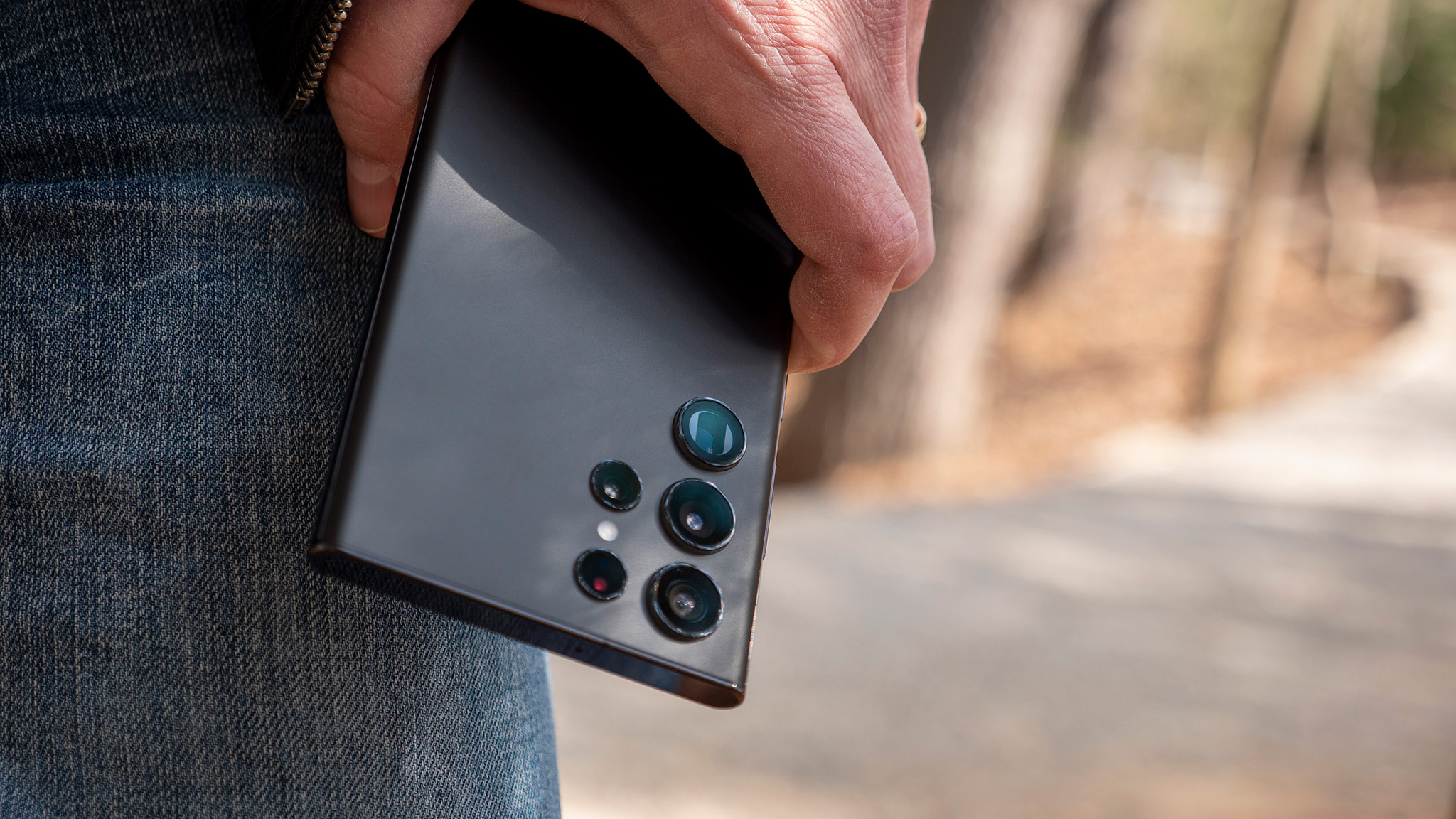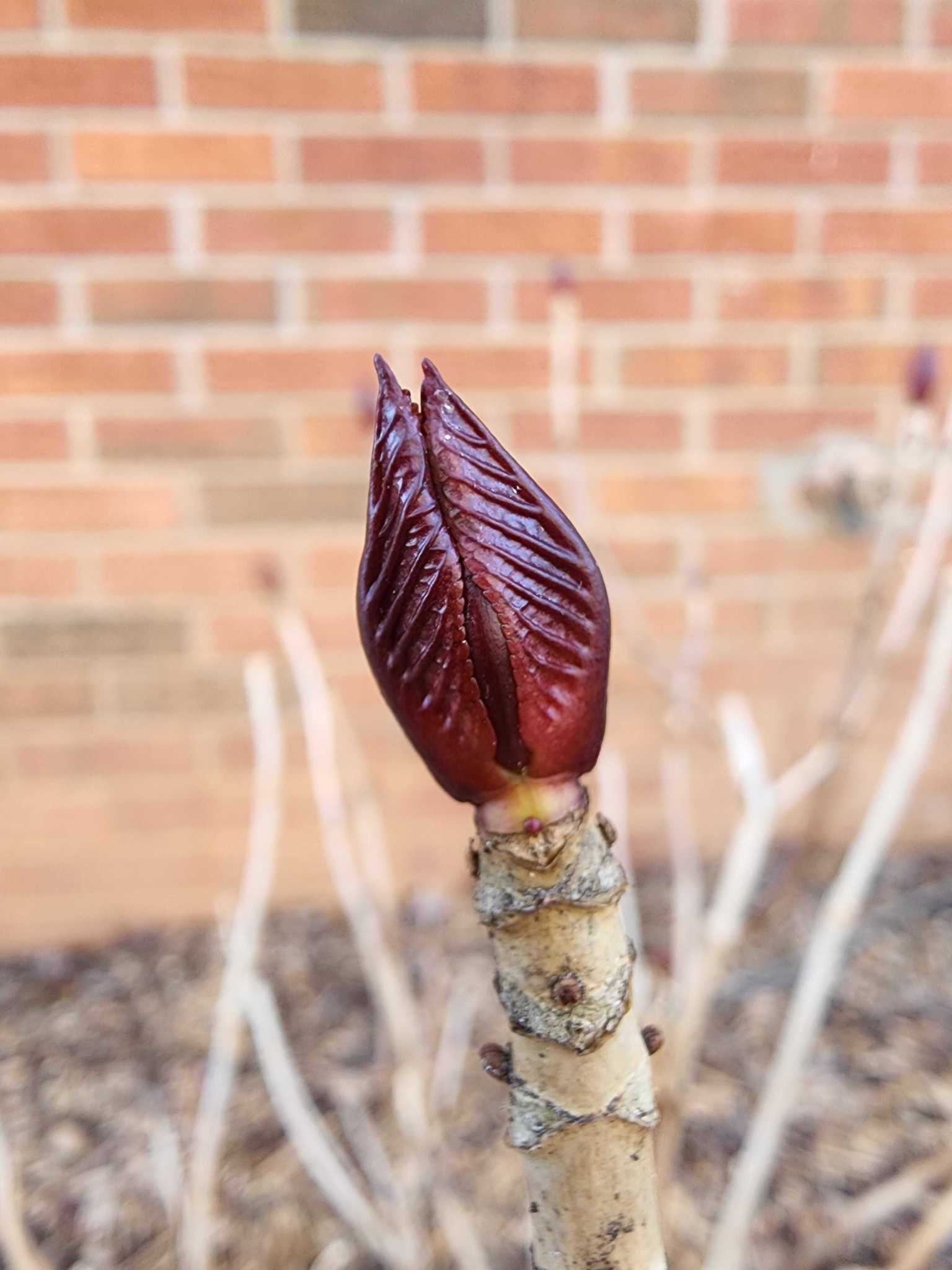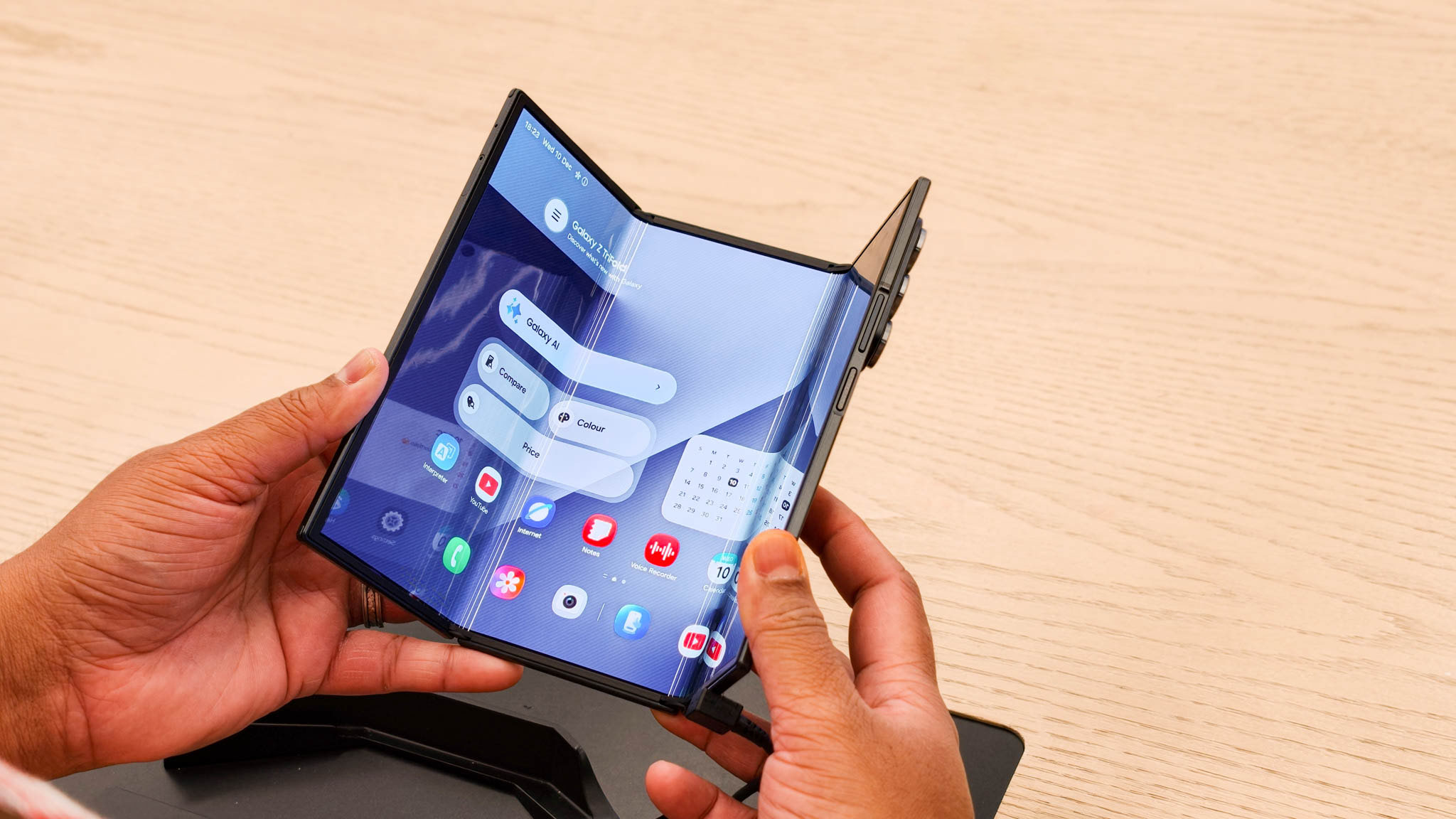Android Central Verdict
The Note is back! This time, with a different name. The Galaxy S22 Ultra is the cutting-edge phone you expect from Samsung, with incredible cameras, super-fast charging, a gorgeous display that's easier to see in sunlight, and the return of the S Pen. It's hard to overlook the fact that the price actually went up compared to last year, there's no 45W charger in the box, and the camera still struggles with some moving subjects.
Pros
- +
Substantial camera improvements
- +
It's literally a Galaxy Note
- +
The S Pen now has a home
- +
Stunning display and performance
- +
45W charging
- +
Software updates for five years
Cons
- -
No charger in the box
- -
Camera has a hard time with some moving subjects
- -
Least expensive version is a downgrade from last year
- -
Performance falters under pressure
Why you can trust Android Central
When rumors began to fly of Samsung's exclusion of the Galaxy Note line from its release schedule, many scratched their heads. The Note has been incredibly popular and has been responsible for pushing larger screens and the resurgence of the stylus in modern devices. It's a triumph, any way you slice it.
Enter the Galaxy S22 Ultra, a dead ringer for what should have been the return of the Galaxy Note series.
To me and, I presume, several others, this branding is very confusing. By all accounts, there was no reason for Samsung to do what it did. It could have just as easily released the Galaxy S22 Ultra as the Galaxy Note 22, and it would have made far more sense. The design is significantly different from the rest of the S22 family, and it's clearly derived from the Galaxy Note 20 Ultra's design.
Just as you would expect from a Note, the Galaxy S22 Ultra pushes the boundaries of specs for a mobile phone. A cutting-edge display, an incredibly powerful processor, substantially improved cameras, and even an S Pen inside the body. This is the phone Note enthusiasts have waited for.
But that last thought precisely precludes the S22 Ultra's audience. This is an enthusiast's phone at an enthusiast's price. Samsung tried to hide the price increase by offering a model with less RAM and storage, but the price for a phone that's specced more comparably to last year's S21 Ultra is $100 more.
Is the Galaxy S22 Ultra worth it? Find out in our Galaxy S22 Ultra review.
Phone deals: Best Buy | Walmart | Samsung | Amazon | Verizon | AT&T
Get the latest news from Android Central, your trusted companion in the world of Android
Samsung Galaxy S22 Ultra: Price and availability

Samsung made an interesting decision with the least-expensive Galaxy S22 Ultra, which starts at $1,199 and offers just 8GB of RAM and 128GB of storage. That's the same launch price as the Galaxy S21 Ultra but with less RAM.
The remainder of the Galaxy S22 Ultra models offer 12GB of RAM and additional storage. The Galaxy S22 Ultra with 12GB of RAM and 256GB storage sells for $1,299, while Samsung offers additional configurations with 512GB and 1TB of storage for $1,399 and $1,499.
The Galaxy S22 Ultra is available in four colors from retailers and carriers: Phantom Black, Phantom White, Green, and Burgundy. Three additional colors can only be obtained by ordering the phone from samsung.com: blue, red, and gray.
Samsung is expected to introduce the Galaxy S23 series — including the Galaxy S23 Ultra — on February 1, 2023. If you haven't bought a Galaxy S22 Ultra yet, definitely wait for the next generation before you make a decision. At the least, you can probably score a Galaxy S22 Ultra for far less once the S23 Ultra launches.
Samsung Galaxy S22 Ultra: Hardware and design
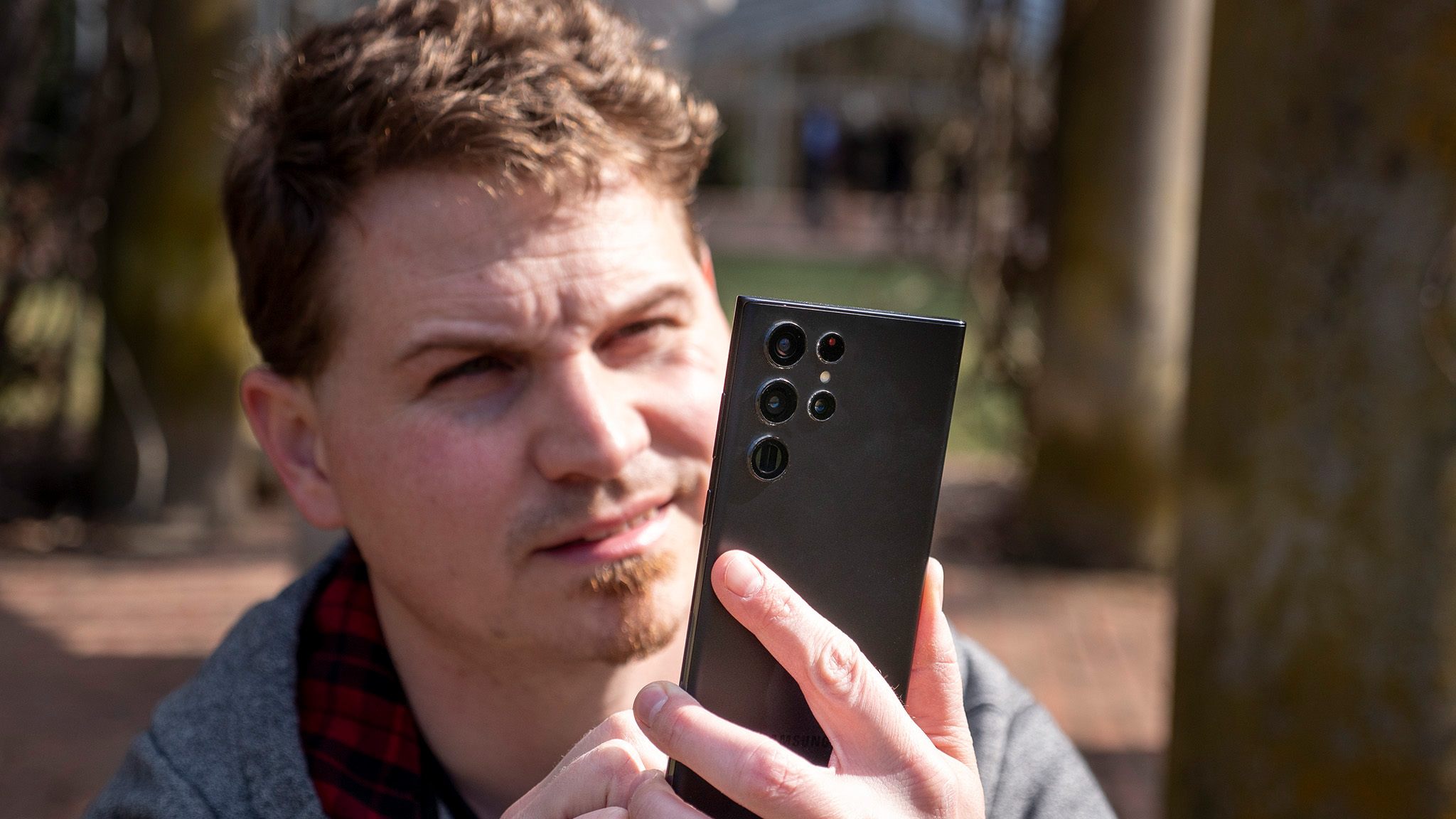
Anyone upgrading from the Note 20 Ultra will feel immediately familiar with the Galaxy S22 Ultra. They're practically identical on the outside.
If you've ever used a Galaxy Note 20 Ultra, you'll know exactly what to expect here. Except for a few extremely minor tweaks to the size — and, of course, those cameras on the back — the Galaxy S22 Ultra looks and feels identical to the Note 20 Ultra. That's good since this phone is the proper successor to that device, and anyone who upgrades will feel immediately familiar with it.
| Category | Galaxy S22 Ultra |
|---|---|
| Operating System | Android 13 with One UI 5 |
| Chipset | Snapdragon 8 Gen 1 |
| Display size | 6.8-inches Edge, Dynamic AMOLED 2x, 3088 x 1440 1-120Hz refresh rate, 240Hz touch sampling (game mode) |
| Frame | Gorilla Glass Victus+ front and back, Armor Aluminum frame |
| Memory | 8GB or 12GB |
| Storage | 128GB, 256GB, 512GB, 1TB |
| Expandable Storage | No |
| Rear Camera | 108MP, ƒ/2.2, 0.8μm, (85-degree wide-angle) 12MP, ƒ/2.2, 1.4μm (120-degree ultra-wide) 10MP, ƒ/2.4, 1.12μm, 3x optical zoom (telephoto) 10MP, ƒ/4.9, 1.12μm, 10x optical zoom (telephoto) |
| Front Camera | 40MP, ƒ/2.2, 80-degree wide-angle |
| Battery | 5,000mAh 45W Fast Charging 15W Wireless Charging 4.5W reverse wireless charging |
| Security | in-display ultrasonic fingerprint scanner (4x9 mm size) |
| Wireless | Bluetooth 5.2, 5G, Wi-Fi 6E |
| Dimensions | 163.3 mm x 77.9 mm x 8.9 mm |
| Weight | 229g |
| Water and dust resistance | IP68 |
| Colors | Phantom Black, Phantom White, Green, Burgundy Samsung.com exclusive: Red, Blue, Grey |
As someone who has owned multiple Galaxy Note devices over the years, I've never liked the boxier design the series took on, which began with the Note 10.
For me, this design is less comfortable to use than the regular S22. I think it's a step back from the S21 Ultra, with its lovely curves that make it more pleasant to hold, especially one-handed.
As someone who has owned multiple Galaxy Note devices over the years, I've never liked the boxier design the series took on, beginning with the Note 10. I was happy to see the S21 Ultra get S Pen support last year because it meant a more rounded-off phone had S Pen support.
Too bad that was fleeting.
In short, 90-degree angle phone corners are not something I enjoy using day-to-day.
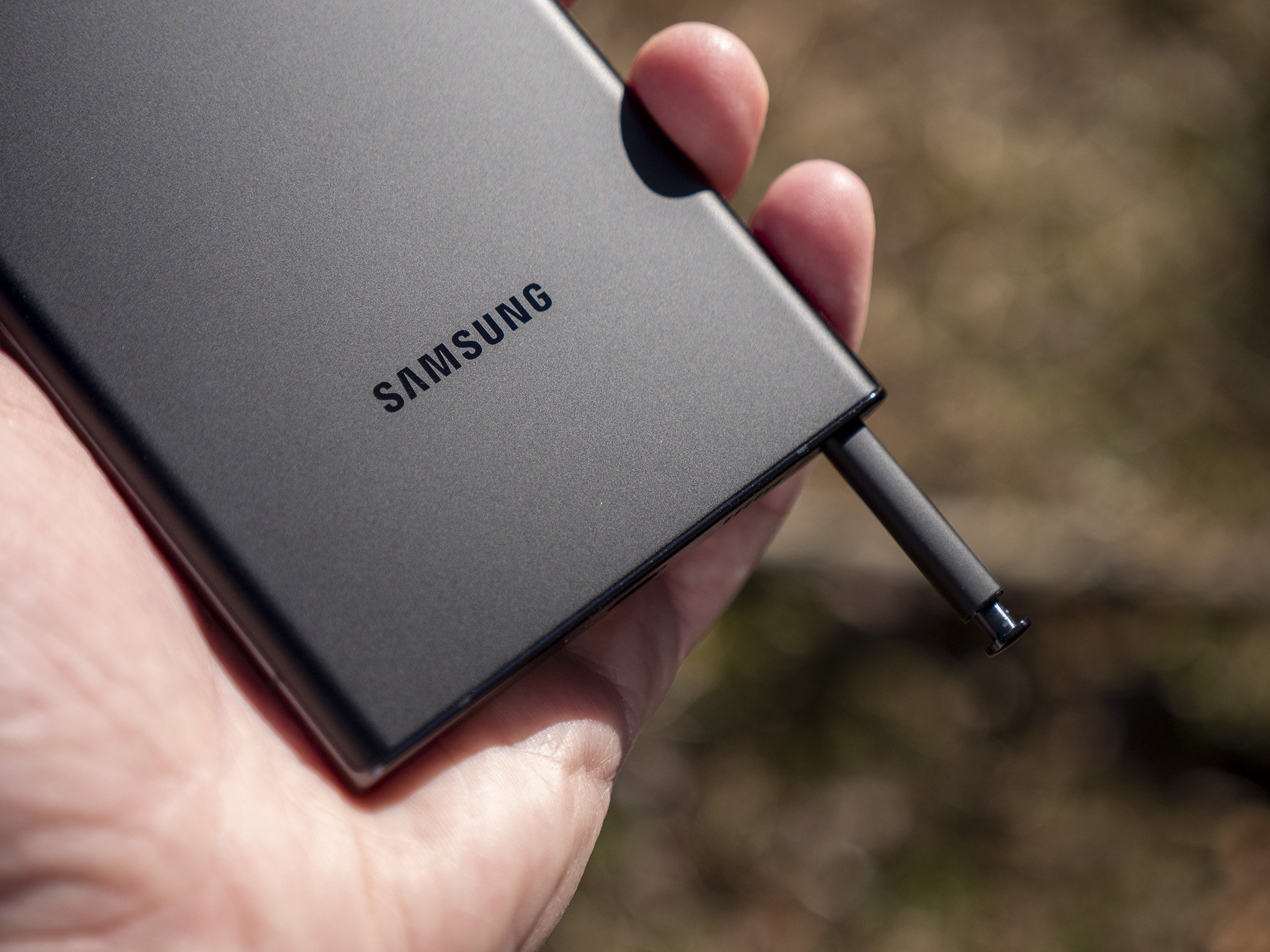
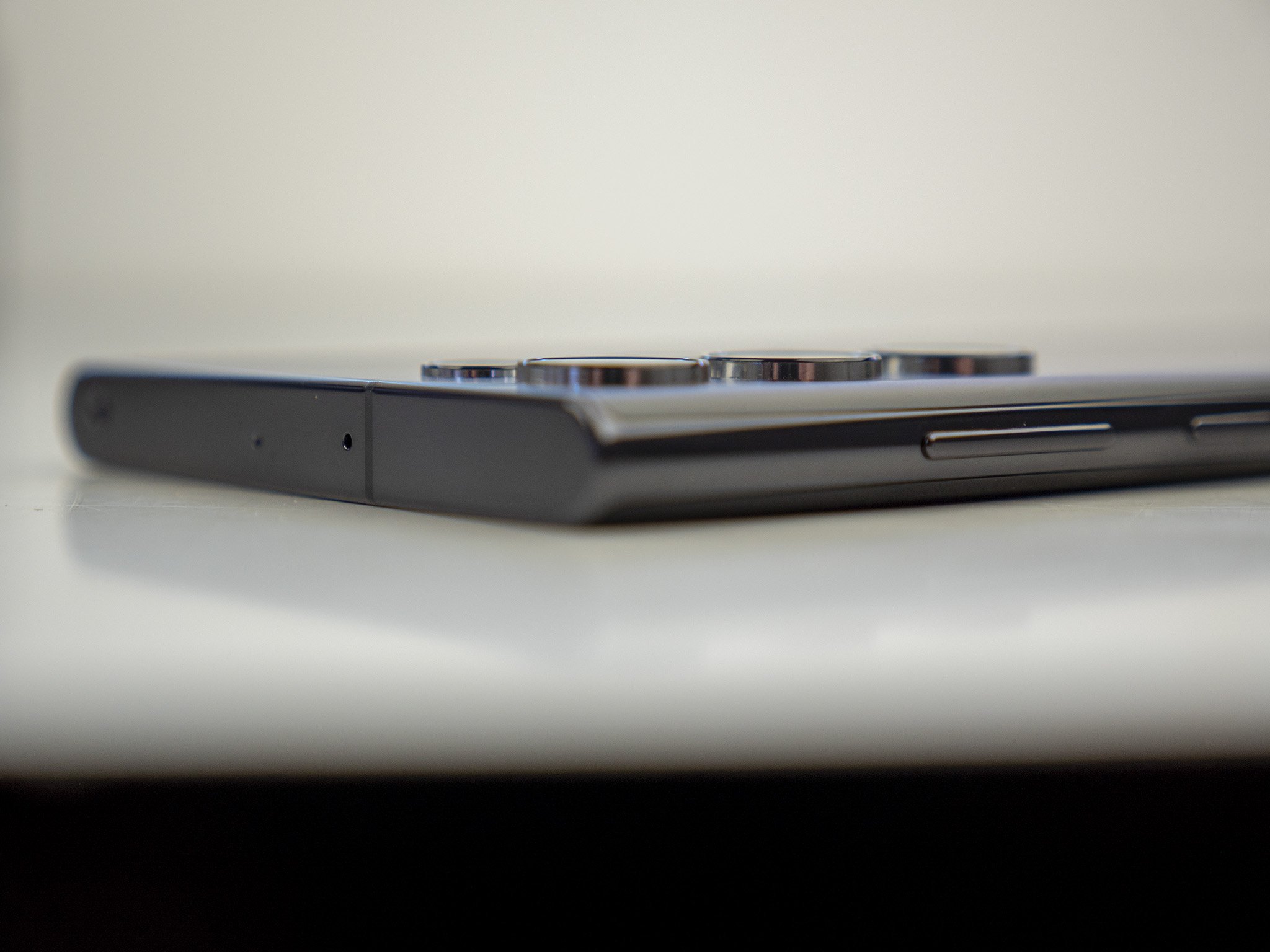
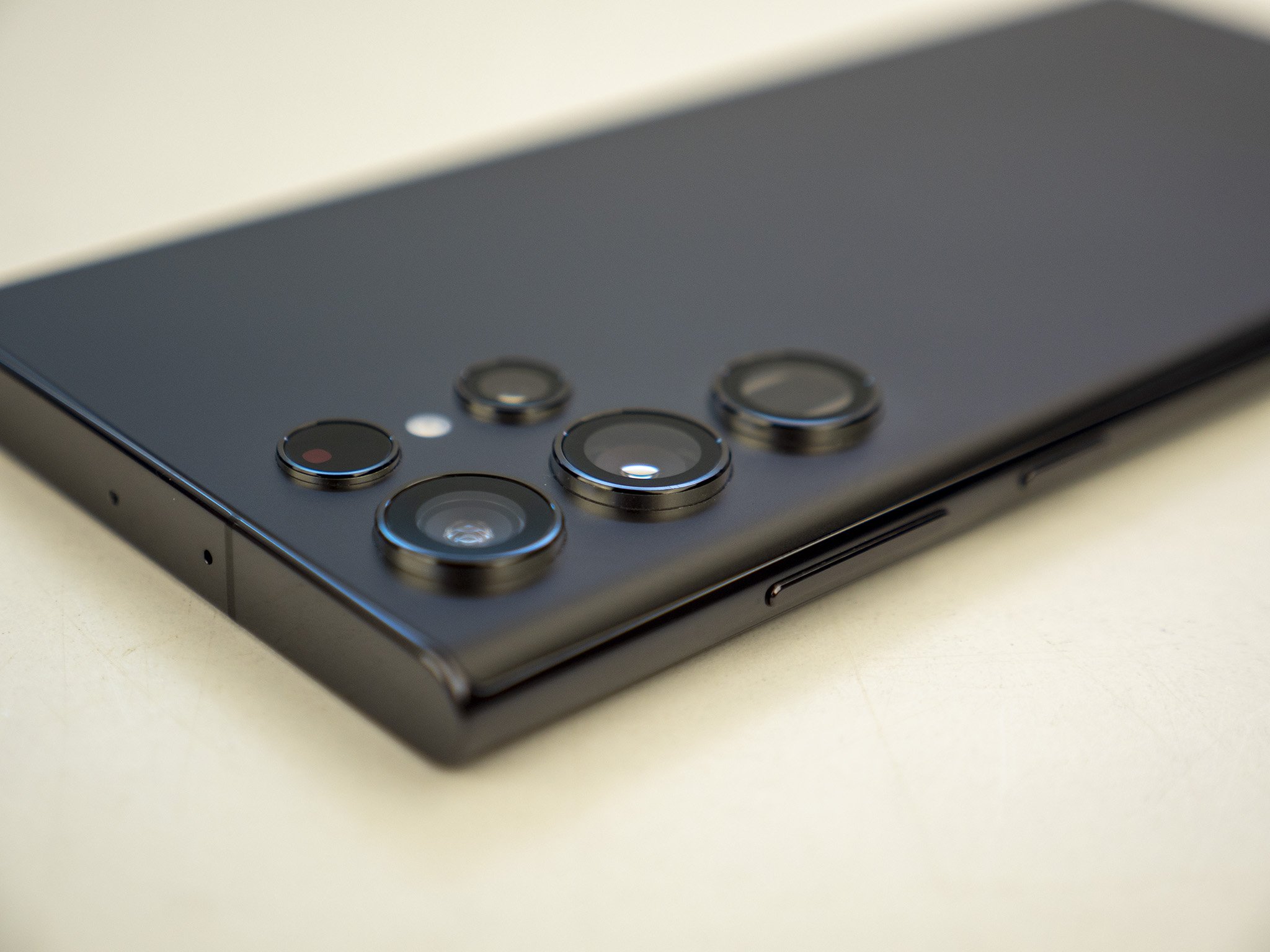
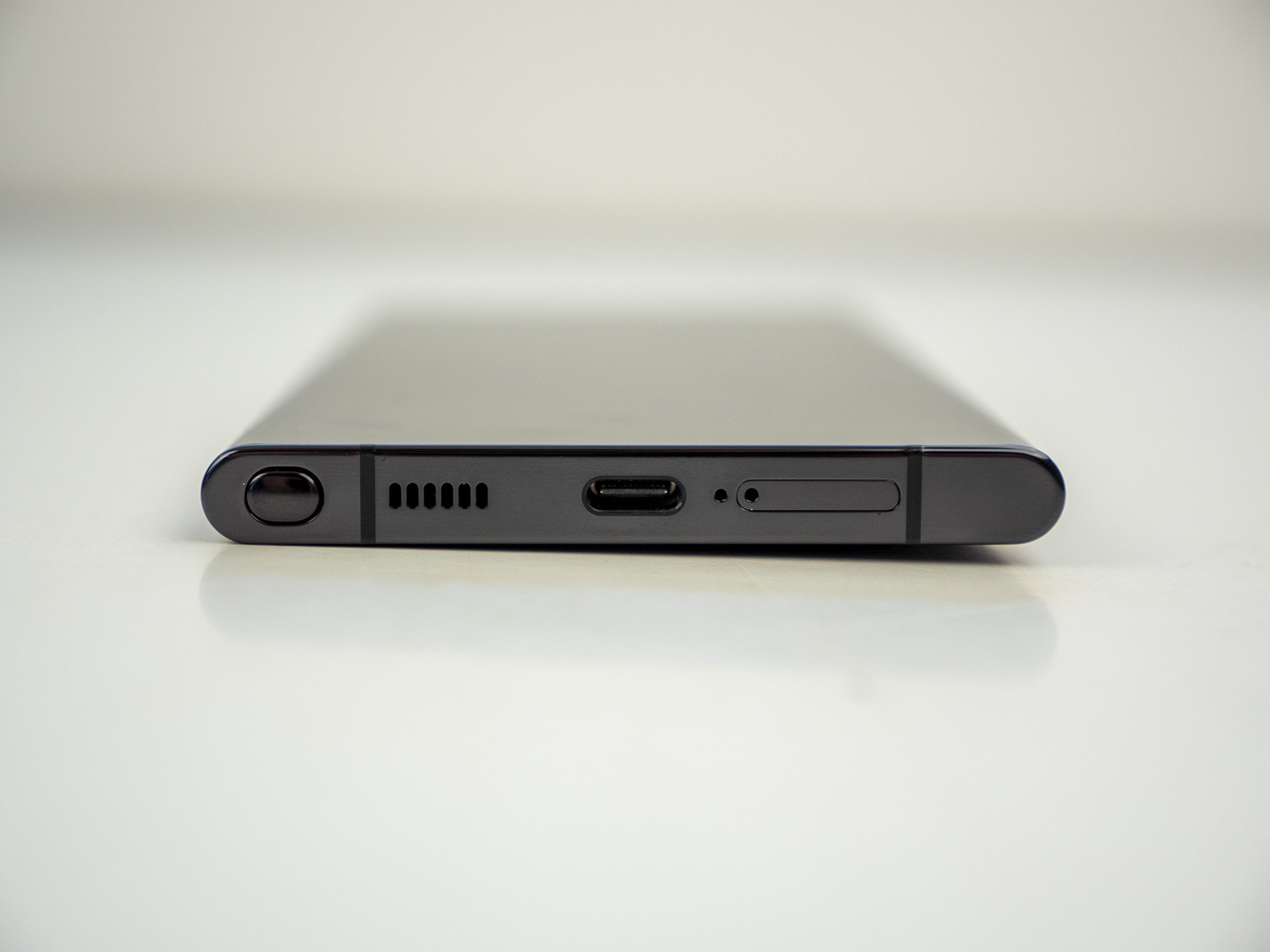



I had thought I scratched up the back pretty noticeably. Thankfully, removing them was as simple as wiping the back of the phone with a microfiber cloth.
The phone itself is rather heavy at 229g — that's the same weight as the S21 Ultra — and the fogged glass back and perfectly rounded edges mean this one is super difficult to hold onto in colder or less humid weather.
Samsung outfitted the S22 Ultra with Gorilla Glass Victus+ — a first for any phone — and it seems to do an admirable job of keeping scratches and scuffs at bay. In the image above, I had thought I scratched up the back pretty noticeably. Thankfully, removing the scratches was as simple as wiping the back of the phone with a microfiber cloth. However, it's still worth considering picking up a good screen protector if you're worried about damaging your display.
But there's no getting around how terrible this camera module design is. Those five massive cameras — all of which protrude from the back of the phone a few millimeters — toss the phone off balance when laid down on a table. Many modern phones wobble because of their off-center camera modules, but this one is particularly annoying because it makes note-taking on a flat surface more difficult than it should be.
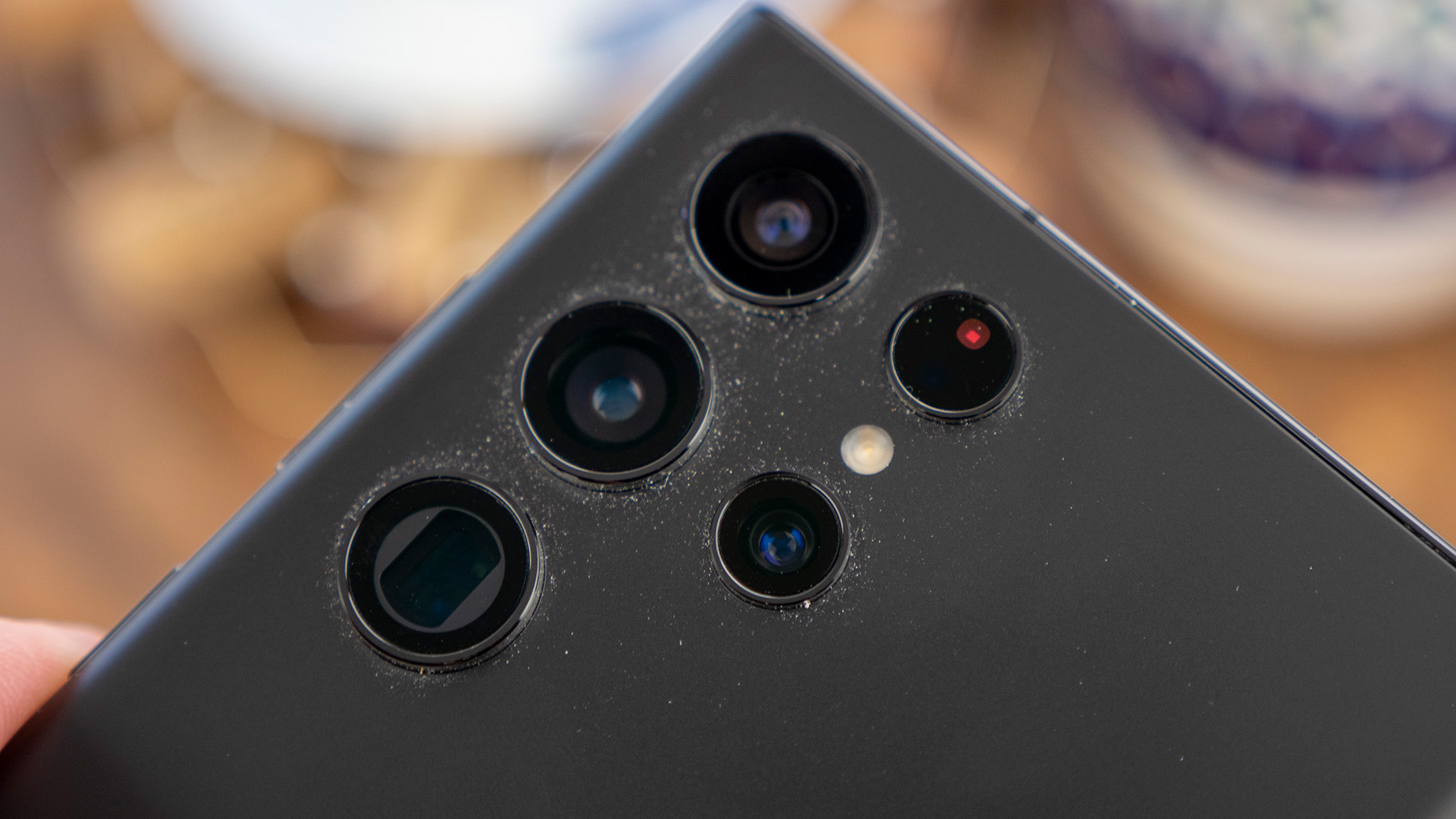
Since the S22 Ultra has no interlocking metal contour as the rest of the S22 family has, those camera modules are going to attract every little bit of dust, lint, and hair that your pockets can gather.
It wouldn't be so bad if they were easy to clean off. As it stands, the only way I could remove all the dust was to wash the thing off, and usually, drying it reintroduced dust even if I used a microfiber cloth. It's maddening.
Overall, I'm not a huge fan of this phone's design.
I also find the Galaxy S21 and S22/S22+'s metal contour design around the camera very attractive. The disconnected lens design of the S22 Ultra is both uglier and less distinctive. Overall, I'm not a huge fan of this phone's design.
If this will drive you as crazy as it makes me be sure to get one of the best Galaxy S22 Ultra cases. Personally, I prefer the matte black CaseBorne ArmadilloTek S case, and Smarter's Wallet Slayer case will make the S22 Ultra an even more all-in-one solution, all while making it more comfortable to hold.
Samsung Galaxy S22 Ultra: Display and S Pen
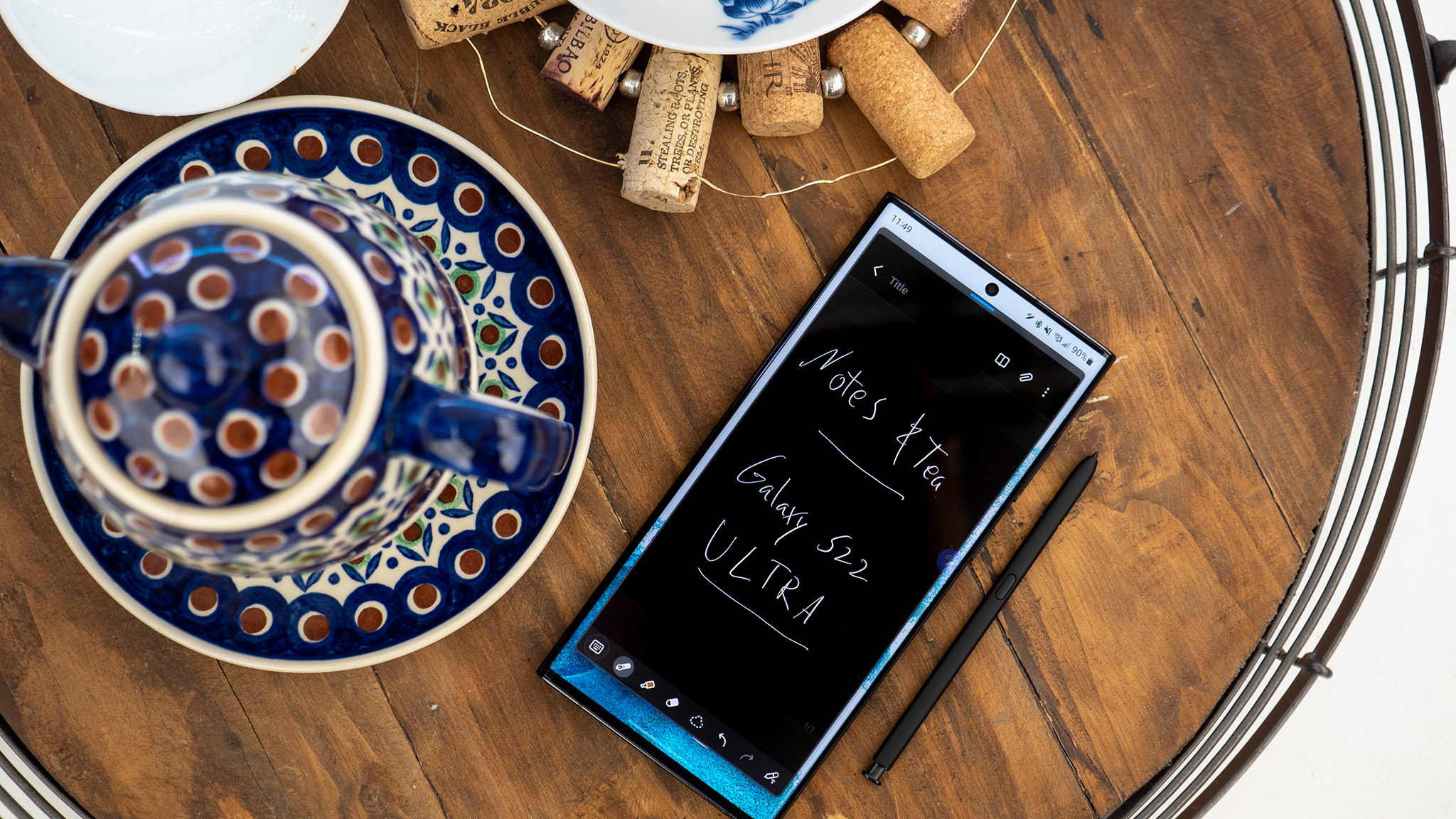
While the design isn't my favorite to hold, it's certainly conducive to housing the S Pen inside. Given there's little difference in the size of the S22 Ultra compared to the S21 Ultra — that's 2 mm shorter and 2 mm wider — it's impressive to see Samsung somehow got an S Pen to fit inside.
Given there's little difference in the size of the S22 Ultra compared to the S21 Ultra, it's impressive to see Samsung somehow got an S Pen to fit inside.
The S Pen itself has also been improved, with a lovely matte finish that makes it far easier to hold onto than previous Note S Pen models. It's still the same tiny little pen though, so don't expect something massively redesigned or even particularly comfortable for larger hands.
Samsung was able to reduce the latency down from 9 ms on the S21 Ultra to 2.8 ms on the S22 Ultra. In short, that means that the S Pen now feels even closer to writing with an actual pen on paper, as it only takes 2.8 milliseconds to draw from the moment you place the pen on the display. Tshaka illustrates this nicely in our video review in his slow-mo comparison between the S22 Ultra and the Note 20 Ultra.
The rubber tip of the pen feels phenomenal and even less like glass than I recall in the past. While the S Pen software is all the same as previous S Pen-enabled devices, the hardware got some noticeable improvements that make the difference.
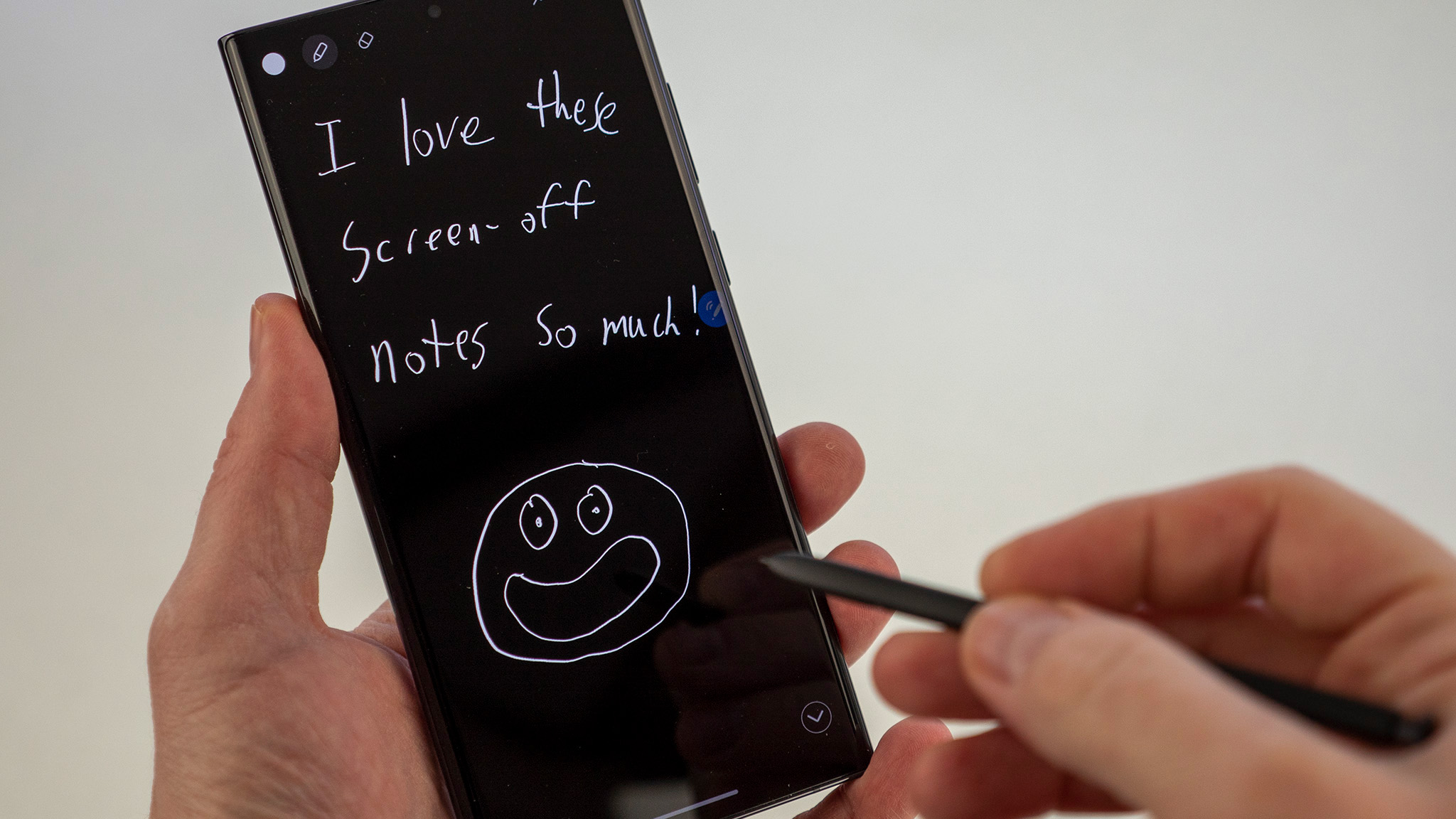
The S Pen now feels even closer to writing with an actual pen on paper.
Hardly a year goes by when Samsung doesn't improve something about its smartphone displays. While this is still an Edge curved display — which will surely irritate some people and makes writing notes more difficult — the rest of the display has been further improved.
It might retain the same WQHD+ resolution and 120Hz refresh rate as last year's Galaxy S21 Ultra, but this year's LTPO tech lets the device drop to as low as 1Hz when static images are displayed on the screen. That puts Samsung on par with OnePlus and Apple's 120Hz displays, all of which are supplied by Samsung, anyway.
Refresh rate changes are all done dynamically and are based on what's happening on screen. If you prefer the best battery life over the prettiest display, it's easy to lock the refresh rate to 60Hz at all times in the settings.
This year's LTPO tech lets the device drop to as low as 1Hz when static images are displayed on the screen.
Samsung's gaming toolbox even lets you lock the framerate at 48Hz for games, giving you a decent balance between relatively smooth gameplay and better battery life while playing.
Two additional new display technologies are also packed inside the Galaxy S22 Ultra: Vision Booster and blue light blocking. Blue light blocking is done through an AI algorithm Samsung says that eliminates the most harmful types of blue light as they occur.
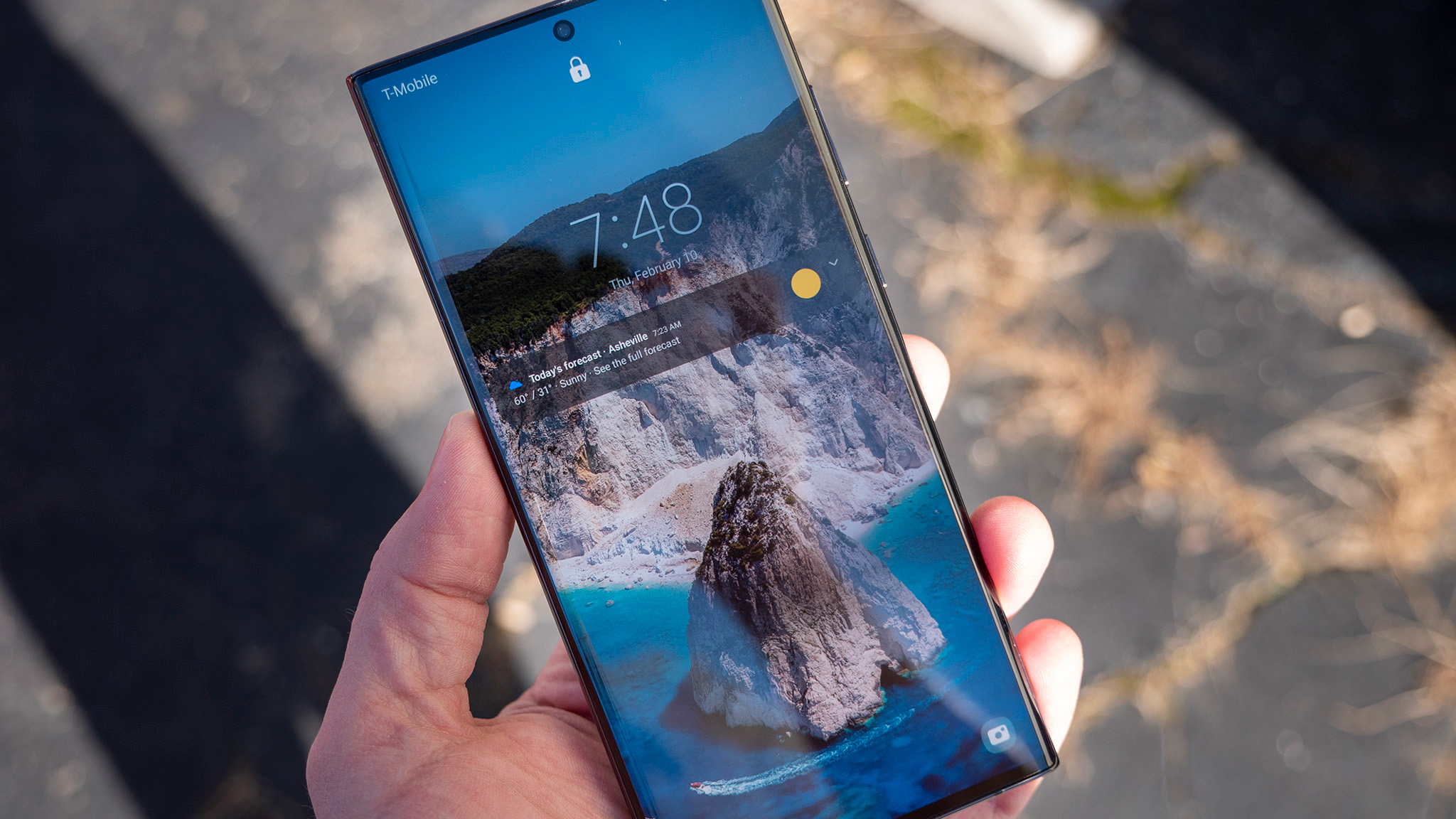
You won't have any trouble seeing this display in any lighting conditions. Ever.
Vision Booster will automatically boost parts of the display up to 1750 nits of brightness when the phone detects that it's in direct sunlight. Comparatively, most other displays max out around 800 nits of brightness, while particularly bright displays might go up to 1,000 or even 1,200 nits.
Additionally, our measured tests showed that the device was able to achieve 1359 nits of brightness when running a fully white HDR video with adaptive brightness enabled. In short, you won't have any trouble seeing this display in any lighting conditions. Ever.
Samsung Galaxy S22 Ultra: Software and performance
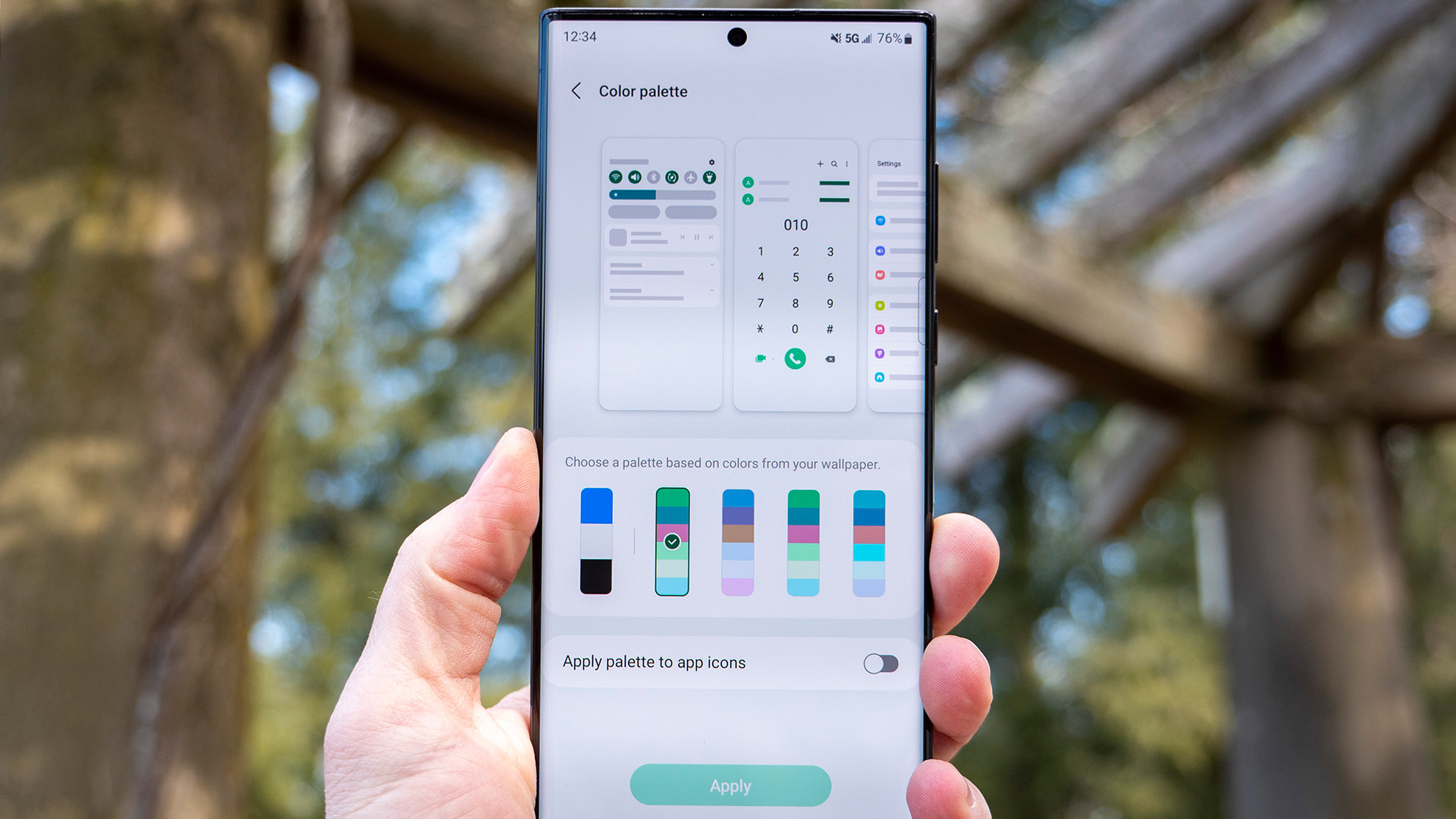
The Galaxy S22 Ultra launched with One UI 4.1, built atop Android 12, which introduced a few tweaks and a handful of new features. Since then, it's received the upgrade to Android 13 with One UI 5 in November 2022 and given a host of new features.
With this comes the most monumental change in Samsung's storied history of smartphone development: regular major Android updates for years after a phone's release.
Samsung is committing to five years of software updates. That includes four major Android updates — up to Android 16 in 2026 — and five years of security updates in total.
With the launch of the Galaxy S22 family, Samsung is committing to five years of software updates. That includes four major Android updates — up to Android 16 in 2026 — and five years of security updates in total.
That makes Samsung the cream of the crop when it comes to software support on Android, and it means that you can rest assured that your phone will get the latest features and be secure for the next five years. That's even better than what Google has promised so far with the Pixel 6.
Samsung is using the Galaxy S22 to launch two major partnership features with Google: Google Duo Live Sharing and Google Messages as the default messaging app.
Google Duo Live Sharing is a new way to watch videos or share your screen with those you're on a Duo video call with. Apps have to be supported, though, and the current list seems a bit short, with Jamboard, Samsung Notes, Google Maps, Samsung's Gallery app, and a few others announced as compatible for now.
What's surprising is that, despite Duo's ubiquitous nature as the built-in video calling app for most Android phones, this feature is exclusive to Galaxy and Pixel phones.
You'll also find that Google Messages looks quite different on the Galaxy S22 series when compared to any other phone. I actually thought it was Samsung messages at first and was overjoyed that RCS finally worked on it.
Instead, Samsung looks to be sunsetting its own messaging app in favor of Google Messages, as Google Messages is the default choice out of the box. That's excellent news for the future of RCS messaging across Android phones.
Google Messages is the default choice out of the box. That's excellent news for the future of RCS messaging across Android phones.
Samsung is also offering up Google's own Material You theme engine as part of the company's new strategy for Android 12 and beyond. Samsung's version of this now themes individual apps — including 3rd party ones — when they support Google's Material You theme engine.
The color picker screen also shows a more detailed color palette this time around, too. Six colors are displayed in a nice, easy-to-understand vertical graph instead of the three-color pie chart from the original One UI release.
I really wish they would have swapped out the default launcher with something better, though, as Samsung's launcher is still garbage and a half. It's also plagued by an irritating bug that takes a good second or two for 3rd party launchers to become usable after swiping home when using gesture navigation.
The Pixel 6 has a similar bug, but Samsung's is more annoying, as the first tap will actually launch whatever app is in that place on the default launcher, often resulting in your launching something like messages or phone instead of the app you intended.
While it might sound like a performance-related issue at first, this one is definitely a bug that needs to be addressed by either Samsung, Google, or both. I did run into a few performance-related issues during my time with the S22 Ultra, though, and it makes me worry at least just a little bit for the new Snapdragon 8 Gen 1 processor inside the U.S., Canadian, and Chinese variants.
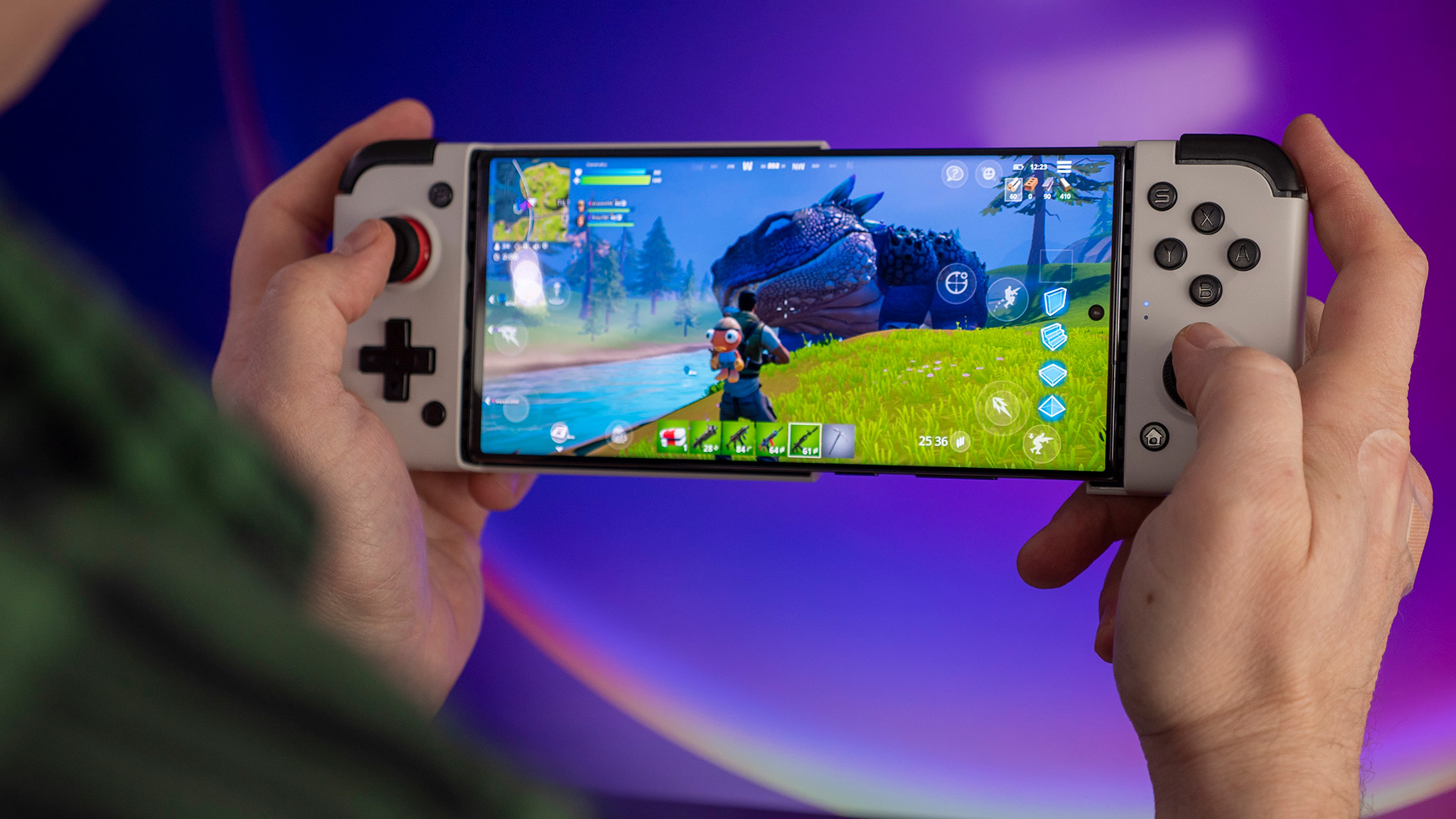
At least a few times, I had issues with stuttery scrolling performance in apps like Twitter.
Since its announcement, there have been questions surrounding the Snapdragon 8 Gen 1's ability to regulate a good balance between heat output and good performance. Our own Michael Hicks can attest to his Galaxy S22+ getting extremely hot during gaming sessions, specifically that "the S22+ feels like it's been sitting on asphalt for a few minutes after playing Genshin."
I haven't had those kinds of obvious physical temperature issues with the S22 Ultra, but I ran across a few situations where the device seemed to struggle in odd ways. At least a few times, I had issues with stuttery scrolling performance in apps like Twitter, which can be seen in this video.
Additionally, on one fateful Saturday, while playing Fortnite for an hour and a half with my son, I came across what unmistakably looks like GPU heat-related visual glitches. These aren't just cosmetic, either. They affect gameplay because the game constantly stutters while this happens.
Now, I only ran across this Fortnite glitch on a single day in my testing. I was unable to replicate it the next day, where I played for just shy of 3 hours with my son. Additionally, I played an hour and a half of Genshin Impact on Tuesday and never came across any similar visual glitches. Samsung told me it was able to replicate this Fortnite glitch and that it has since been solved in a software update.
I've found that the phone's performance throttling noticeably affected gameplay for me.
While S22 Ultra can be noticeably faster than the S21 Ultra and any other Snapdragon 888-powered phone, that difference doesn't seem to hold up consistently. According to lab-test results from our parent company, Future, the phone was roughly 25-30% faster in games and benchmarks.
But these initial benchmark results turned out to be not quite accurate, as Samsung was quickly enveloped in a throttling scandal after the Galaxy S22 family's launch. In the short of it, Samsung was throttling the performance of its processor in over 10,000 games and apps. All, of course, except for commonly-run benchmarking applications.
Samsung has since patched this issue, but not before getting itself banned from the GeekBench high score table and creating a good bit of doubt about the performance of the Snapdragon 8 Gen 1 processor inside.
Over the past few weeks, I've found that the phone's performance throttling noticeably affected gameplay for me. Again, while playing games like Fortnite, there's some pretty obvious hitching that happens, all of which can make or break your performance in a close-quarters firefight and end up causing you to lose.
Samsung Galaxy S22 Ultra: Battery
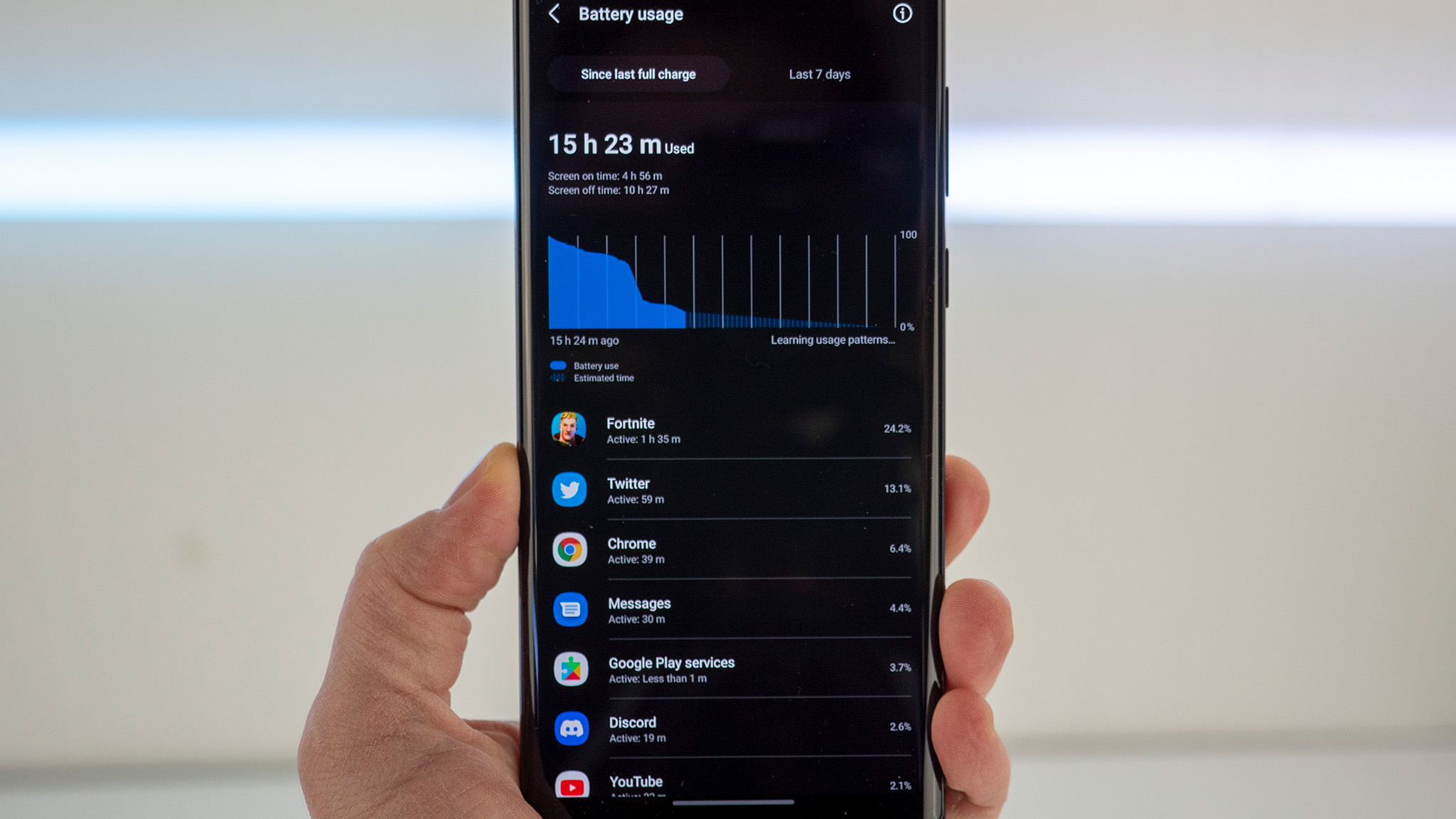
While the battery size may be identical to the Galaxy S21 Ultra, the battery life certainly isn't. In this case, that's not a good thing.
The Galaxy S22 Ultra could only stay alive for 8 hours, 50 minutes compared with the Galaxy S21 Ultra's 11 hours, 25 minutes.
According to the rundown test results — a lab-test from our parent company, Future — at 60Hz, the Galaxy S21 Ultra lasted a very pleasant 11 hours, 25 minutes from full charge to empty battery. However, using the same test, the Galaxy S22 Ultra could only stay alive for 8 hours, 50 minutes.
Synthetic tests aren't always a great representation of real-world use, but this one should give you an idea of what to expect. In the week that I've been using the phone, I struggled to get to the end of heavy use days without charging the phone up.
Most days ended with the battery in the single digits, and that was with me rationing usage toward the end of the evening.
It's a good thing that Samsung upped its charging game to 45W this time around, then, right? Sure, if a 45W charger was included in the box. But there's no charger in the box, and 45W chargers aren't exactly commonplace. At $1,200, I fully expect to get a charger in the box when the phone uses a new standard or increased wattage.
I'm fine with Samsung not including a charger on the smaller S22 or S22+. People commonly have 10W or 15W chargers at home. If you're upgrading from a newer phone, you might have a 25W charger. But 45W chargers are incredibly uncommon, even if you're coming from a flagship Samsung phone.
At $1,200, I fully expect to get a charger in the box when the phone uses a new standard or increased wattage.
But here's the real crux of the thing: a 45W won't actually charge the Galaxy S22 Ultra any more quickly than a 25W charger. It doesn't sound like it makes a lot of sense but tests consistently show that there's almost zero difference in time between the two types of chargers.
At least a 25W charger will get you to 58% charge in only 30 minutes, so it's not a huge deal. Battery life is not an issue on the S22 Ultra by any means, but it's not as good as we've seen from other Samsung flagships.
Samsung Galaxy S22 Ultra: Cameras

Despite the fact that most smartphone cameras are good enough, OEMs continue to highlight how much better the camera experience on the latest phone can be.
The Galaxy S22 Ultra is tied with the Pixel 6 Pro in overall photo capture quality, while it takes the edge in video capture.
Given the hype, I had thought that this would be the year that Samsung actually leaped Google in photo quality. Turns out, that was mostly true, with Samsung picking up most of the wins in the categories below. Samsung takes the overall edge, though, because of its superior video capture and ability to zoom in to distant objects better than any other phone can.
Samsung also further improved its software, making it easier to take better night shots without having to switch to the dedicated night mode. Out of the box, the camera will decide what situations require additional capture time and automatically work its magic.
Samsung dropped all-new sensors into the S22 Ultra, including an upgraded 108MP main sensor, a 12MP ultra-wide-angle camera, and two 10MP telephoto lenses, one sporting 3x optical zoom while the other ups that to 10x optical zoom.
By default, the main camera outputs a 12MP image (4000x3000 resolution), but you can choose to force the full 108MP resolution if you so desire. That 12MP image is derived from a process Samsung calls Nona-binning, which means it takes the 108MP sensor's pixels and divides them into nine equal parts, the fusion of which results in a 12MP image.
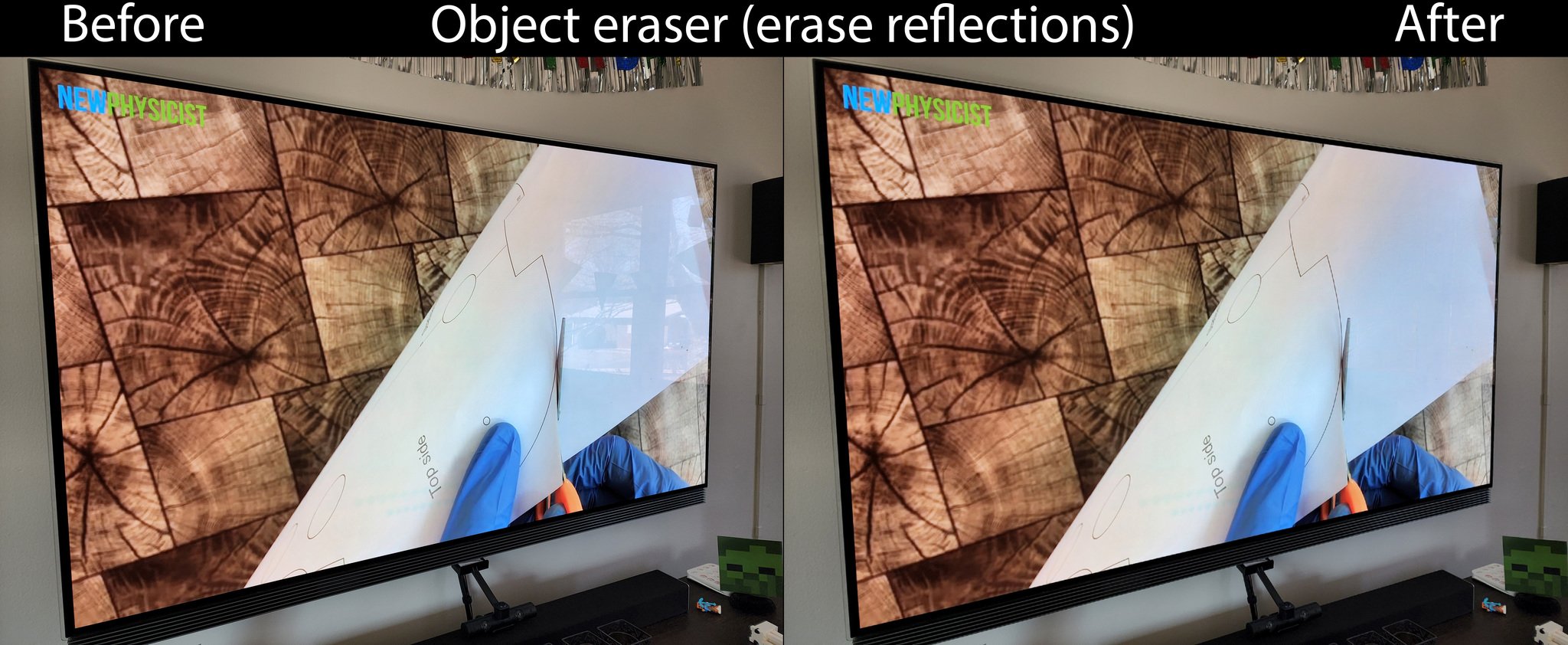
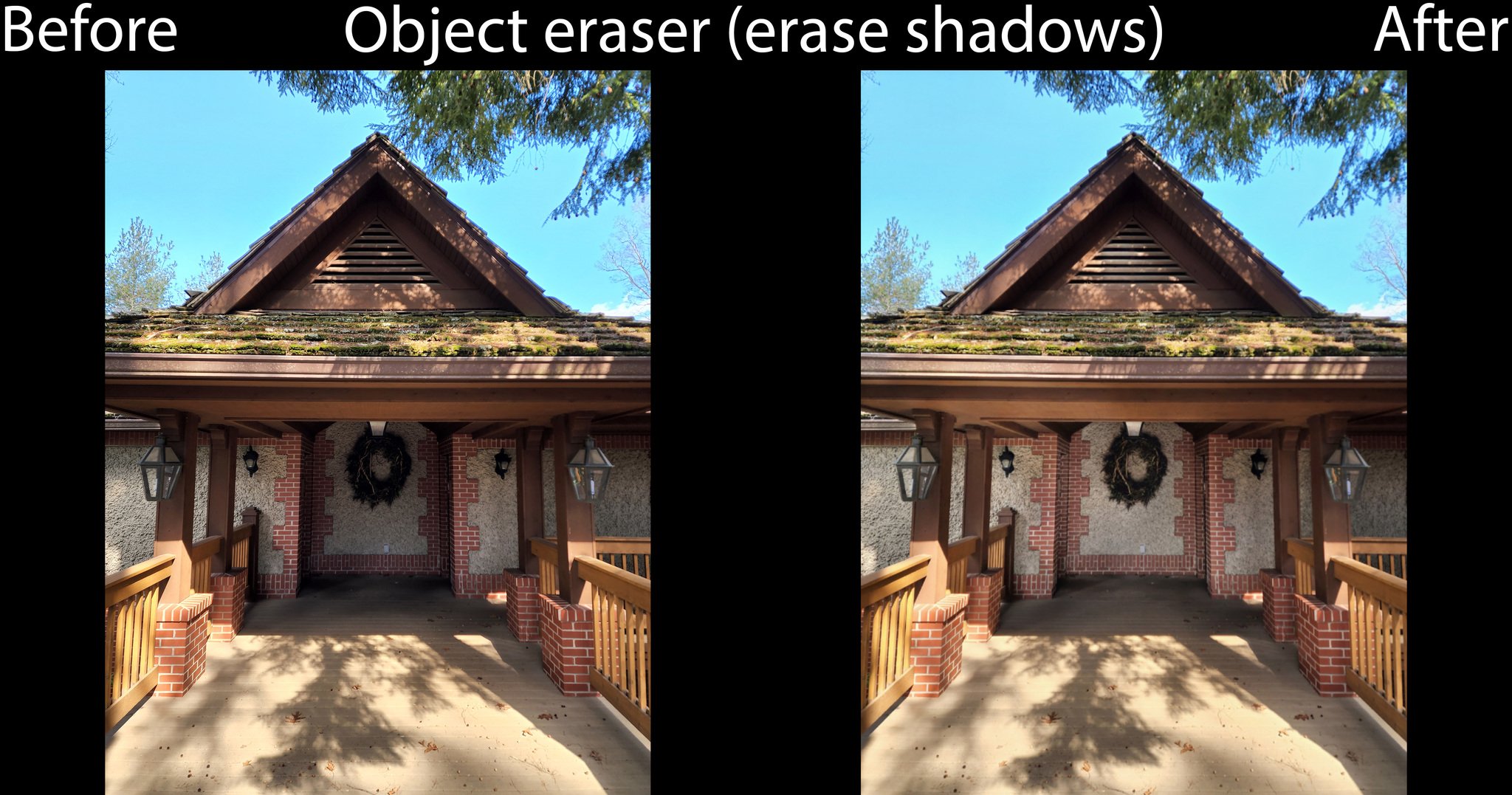
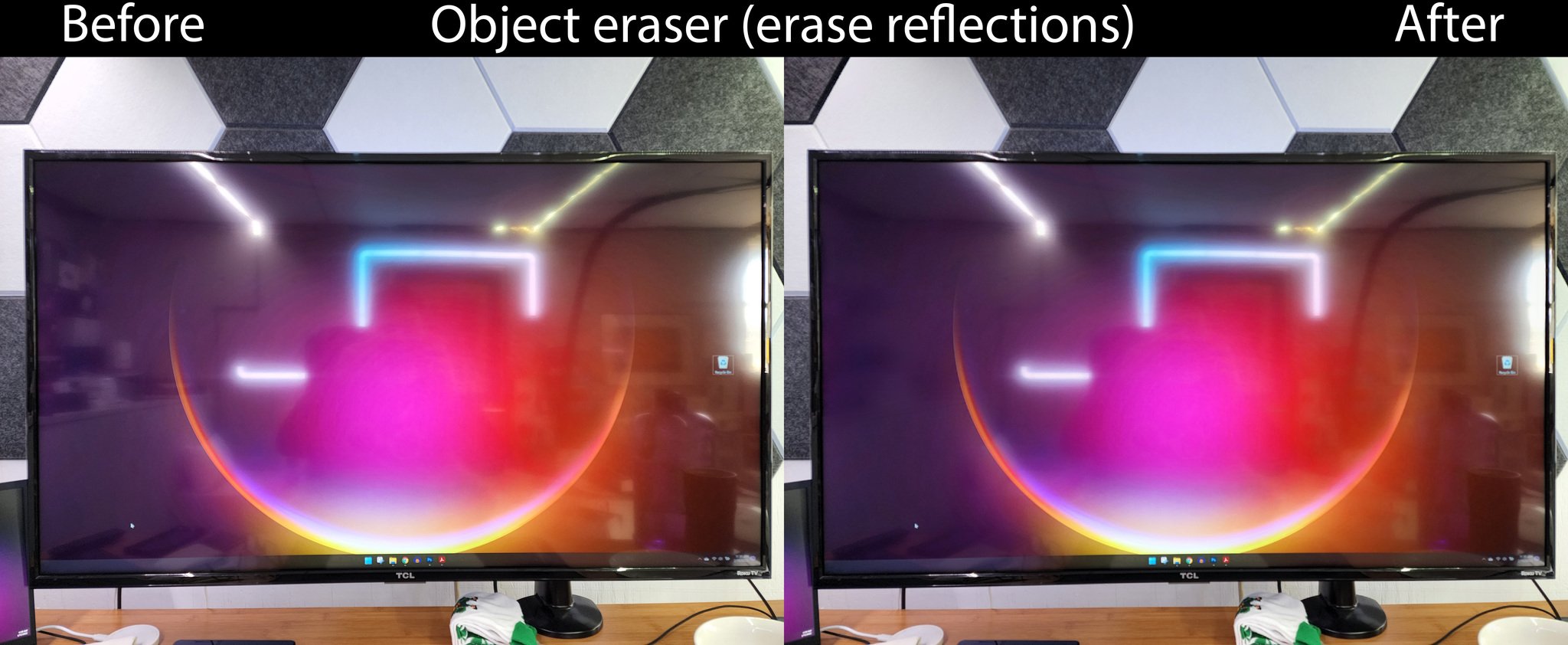
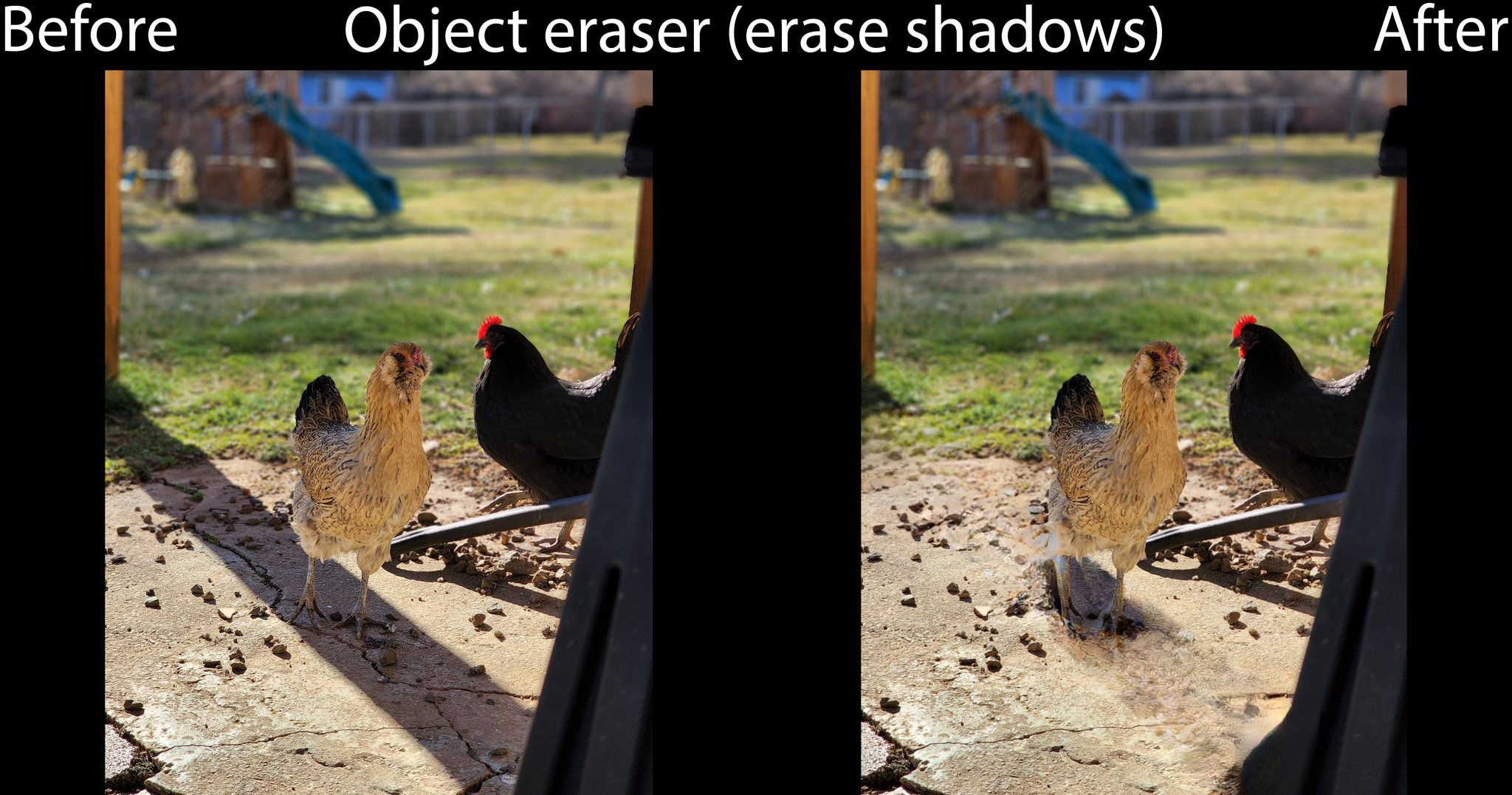
Samsung quietly improved its Object Eraser feature, which can help erase things in photos that you'd rather not be there. The new improvements include the ability to automatically remove shadows and reflections, pitting it better against Google's Magic Eraser feature on the Pixel 6.
As you can see above, the results are pretty fantastic. These were all achieved by just tapping the shadows or reflections button, which, after a moment or two of processing, worked some magic that we haven't yet seen from Samsung phones.
Object Eraser is still hidden in a sub-menu after you edit a photo in the Samsung Gallery app, though, so I'm not sure how many people will go out of their way to use this feature on the regular.
It's a shame, too, because it's both incredibly easy to use and generally returns impressive results.
Main camera
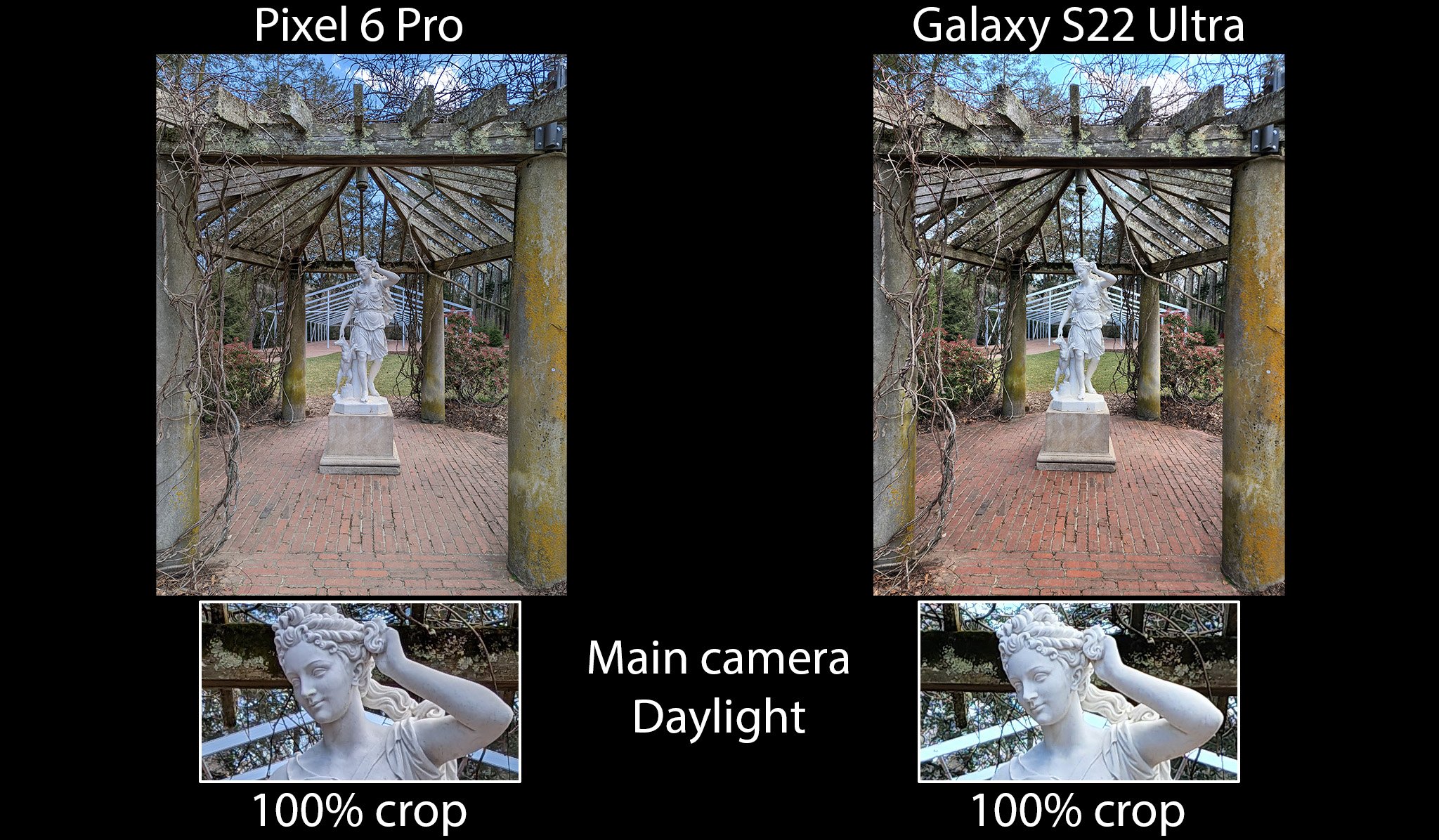
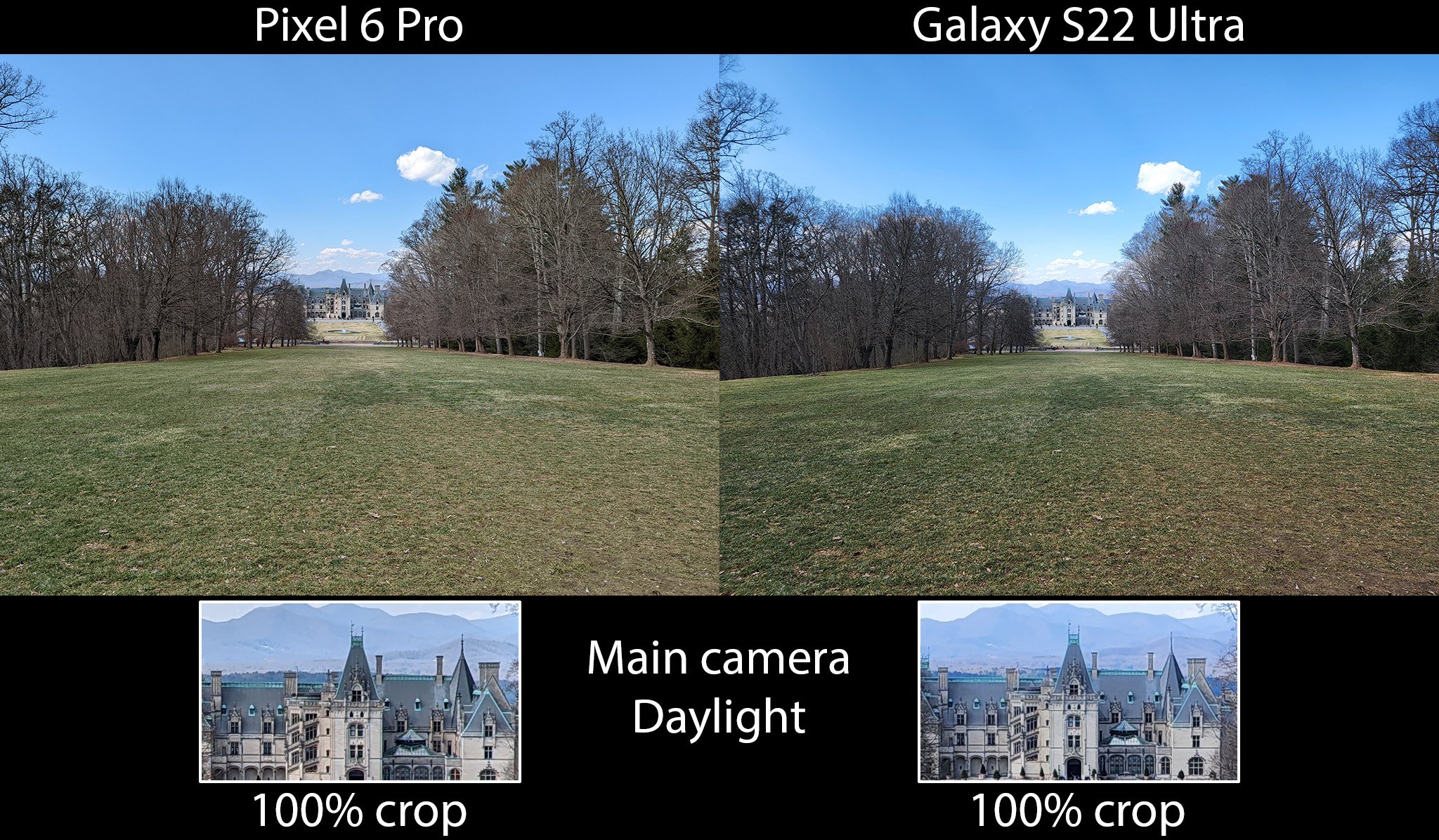

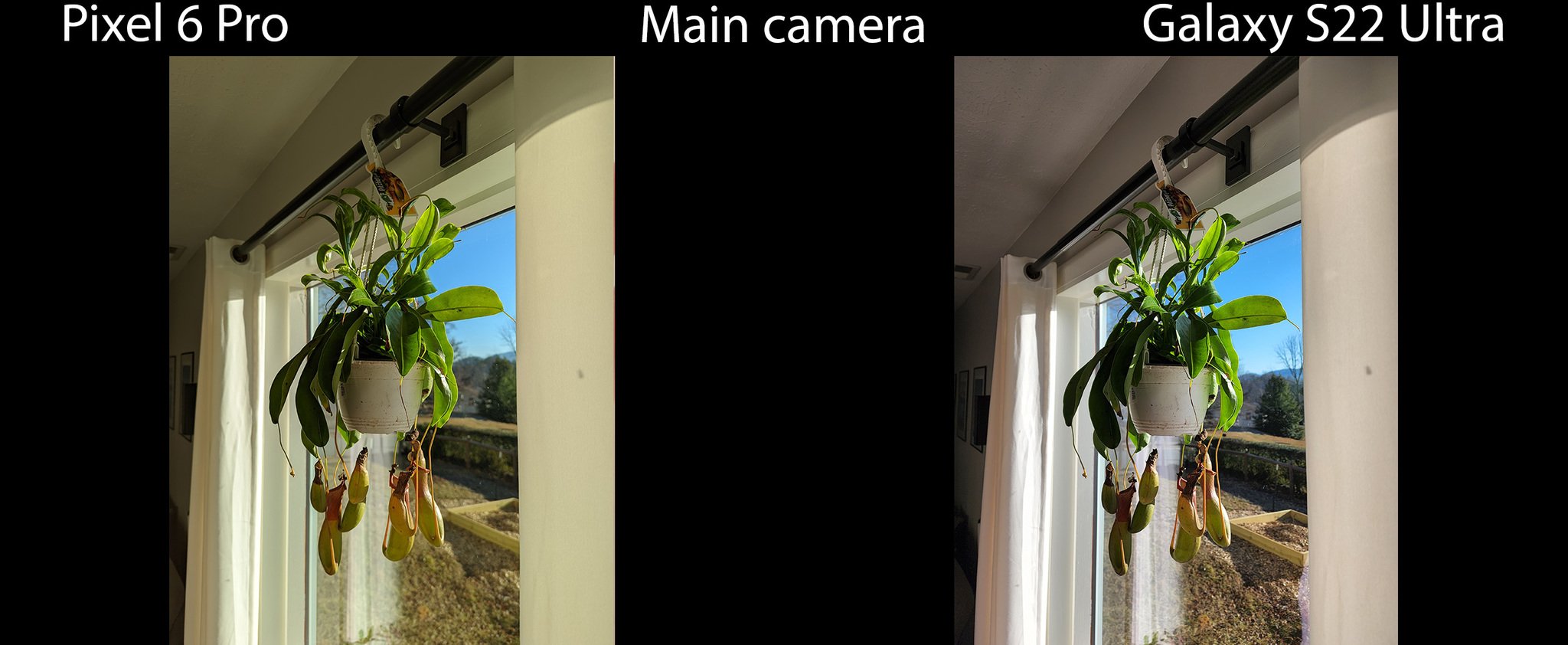


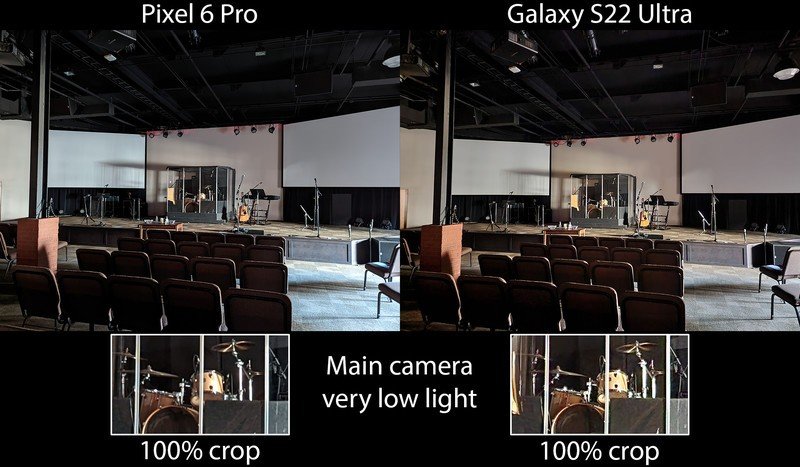

Samsung has monumentally improved their camera software and processing over the past two years alone and, over the past month of testing, it seems that the S22 Ultra trades blows with the Pixel 6 Pro in most lighting conditions.
The Galaxy S22 Ultra's photo processing is worse than the Pixel 6 Pro in situations where dynamic range is the most important aspect.
During the day — and especially when objects are backlit from a window or heavy shadows are involved — the Pixel 6's HDR algorithms always seemed to come out on top. The S22 Ultra regularly has darker shadows and blown-out highlights in bright places like clouds, while the Pixel 6 does a much better job of balancing these extremes.
Zooming in to look at fine detail, you'll notice all the images are crisper and less processed looking on the Pixel 6. Google's default settings are far more color accurate, as well, while Samsung's photos tend to be slightly oversaturated.
But these differences seem to ebb and flow depending on each situation. In some cases, Samsung's photos looked softer and more over-processed than Google's. In other situations — especially in nighttime photography — the Pixel's processing edge drops considerably.
At times, the Pixel 6 Pro pulls out more detail in some nighttime shots. Other times, the Pixel 6 Pro's longer exposure times caused the photos to be blurrier than the S22 Ultra's because of the jitter introduced by free-handing a longer exposure photo.
Either way, both phones shoot superb photos in any lighting condition, and choosing a winner here would be splitting hairs based on very specific situations.
Movement and lens distortion

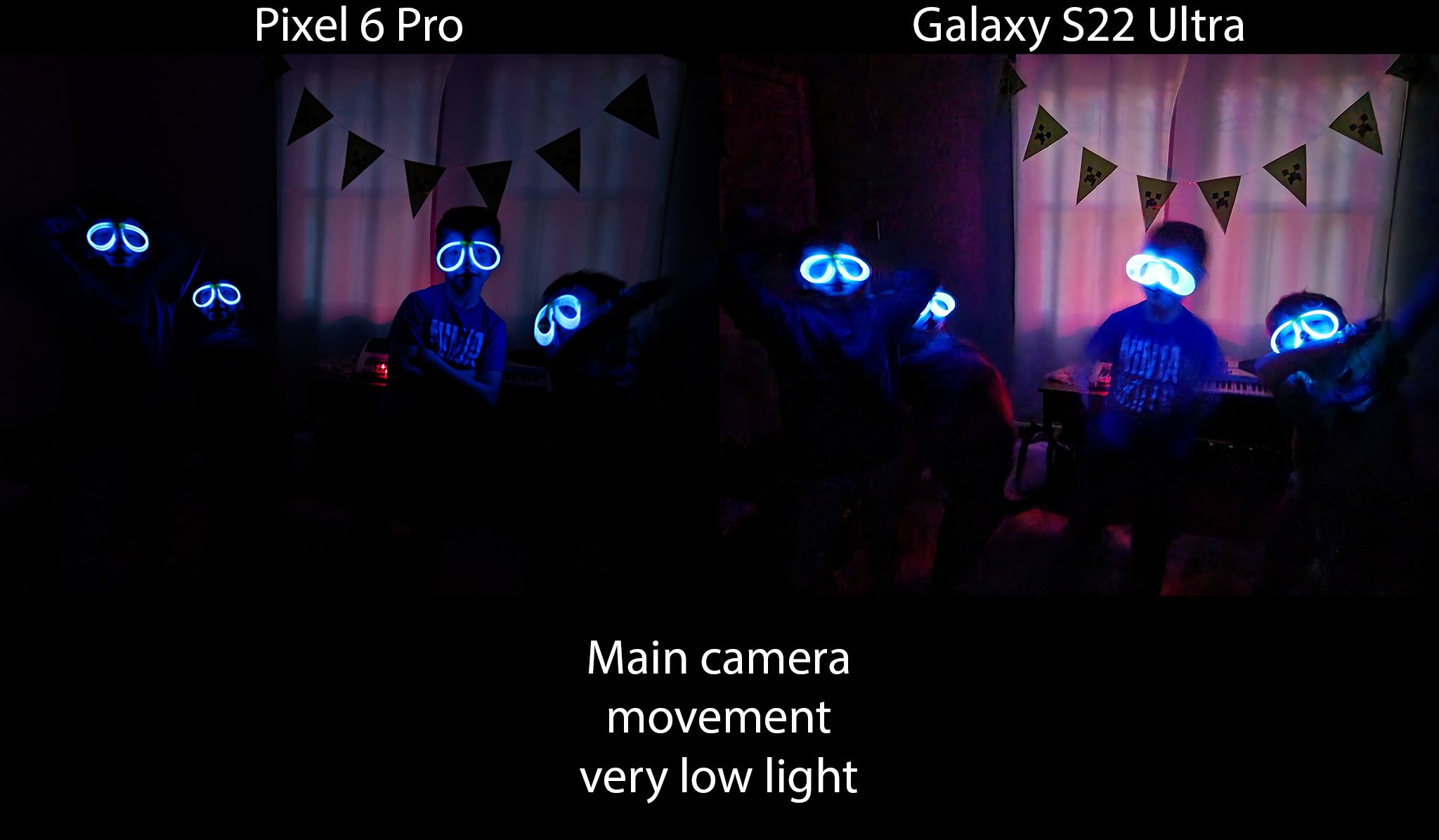
Oftentimes, the Galaxy S22 Ultra utterly failed to take even one decent picture of my son and his friends during the pillow fight at the birthday party.
If there's any place Samsung's cameras still come up short, it's when taking photos of a moving subject. Those moving subjects — pets or kids, in our tests — showed Samsung consistently outranked by Google's Pixel 6.
In these situations, the winner didn't win because we were splitting hairs and nitpicking a photo. Often, the result is that the Galaxy S22 Ultra utterly failed to take even one decent picture of my son and his friends during the pillow fight at the birthday party.
It also had a much, much harder time figuring out what to do when motion occurs during a night mode shot.
Meanwhile, Google's apparently smarter AI algorithms better-identified faces and made sure to capture a clean, unblurred face almost every time, even when there was a ton of movement in challenging conditions.
In our video review, Tshaka was able to overcome many of these issues by sliding the shutter button over to take a series of burst photos, then choosing one that looked good. This is probably a fine alternative option for some people but there's nothing quite like having software that is smart enough to do this for you, which is often the case in Google's camera software.

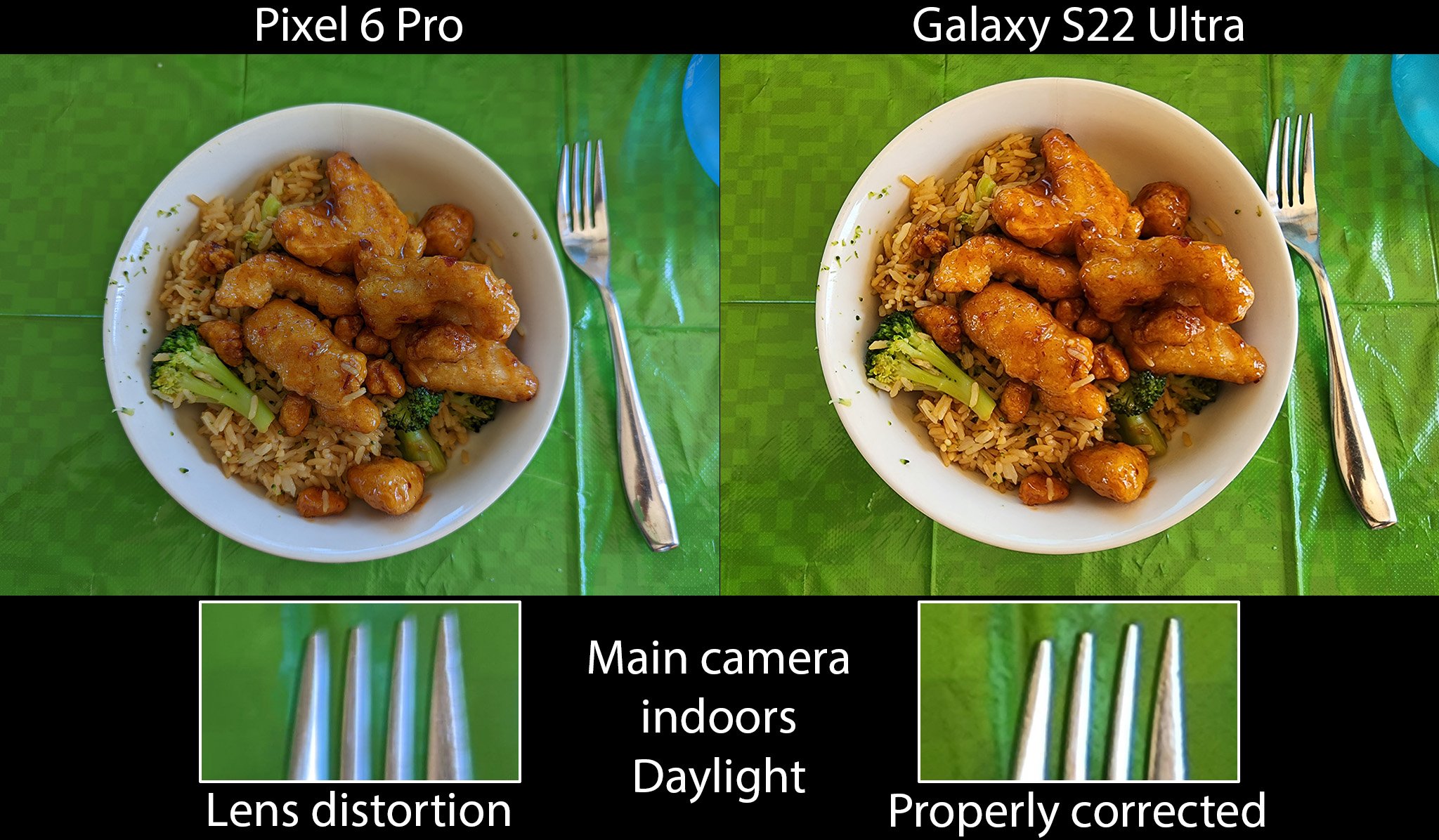
Now here's where the cards start to flip. Samsung's new Focus Enhancer setting — which is enabled by default and can be disabled by tapping the button you see in the screenshot here — does a remarkable job of ensuring that your subject is always in focus.
It means the S22 Ultra does an impeccable job of eliminating lens distortion, while the Pixel 6 Pro regularly has trouble with objects up close. You can see from the examples above how lens distortion tends to crop up on the Pixel 6 when taking shots at close range.
Focus Enhancer does this by a combination of software processing tricks and swapping between cameras to get the best focus.
The Galaxy S22 Ultra does an impeccable job of eliminating lens distortion, while the Pixel 6 Pro regularly has trouble with objects up close.
That even includes an automated macro mode, although it can be tricky to get it to switch to the right camera in some macro circumstances (like taking a picture of a budding flower on a lone stalk).
Still, this shot is something I cannot get on a Pixel 6 from close range. The only alternative is switching to that phone's 4x telephoto camera and standing back a bit, but even that is difficult to capture when Google's software constantly flickers between lenses depending on what it thinks is the correct focal depth.
Telephoto cameras
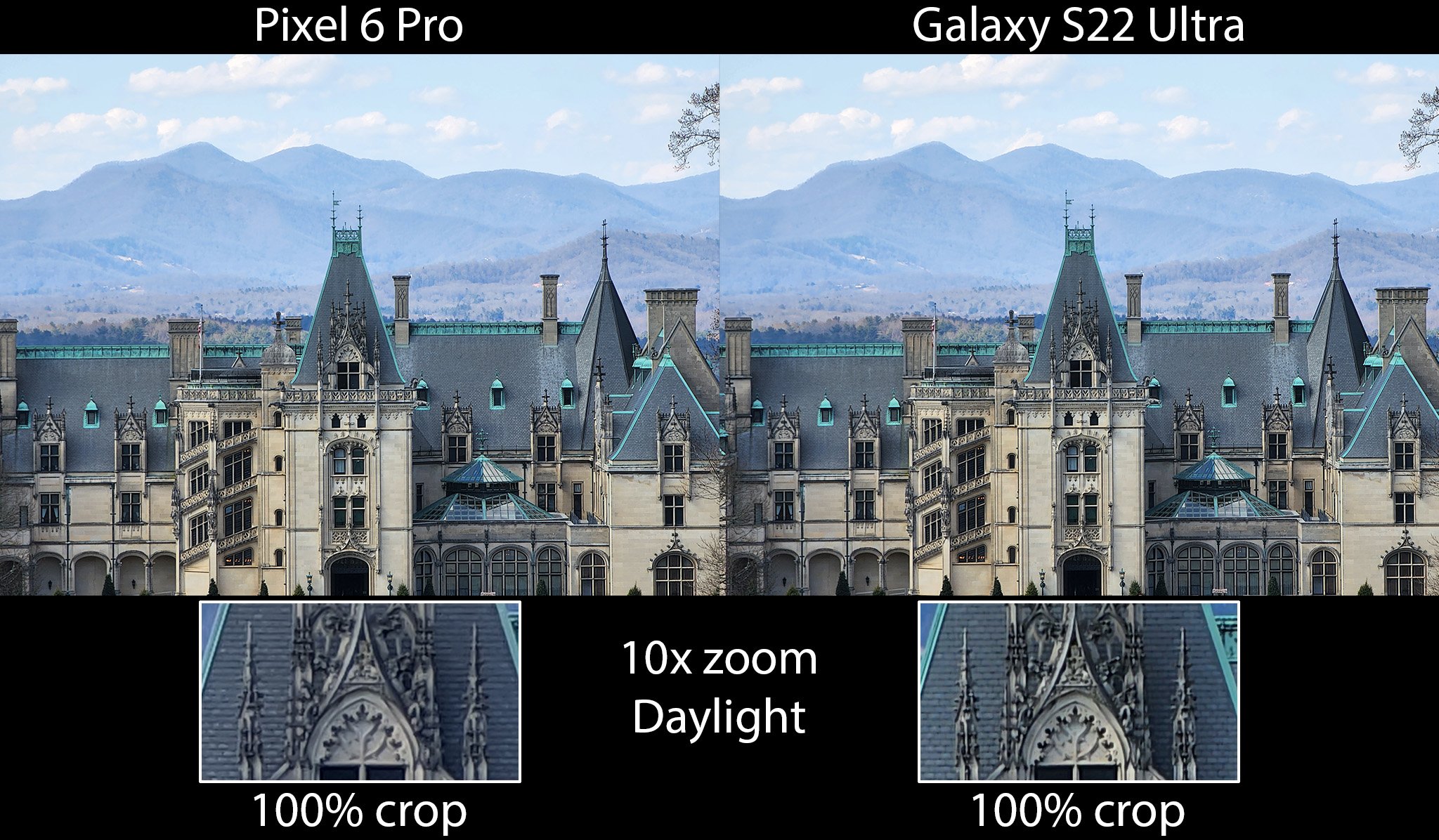
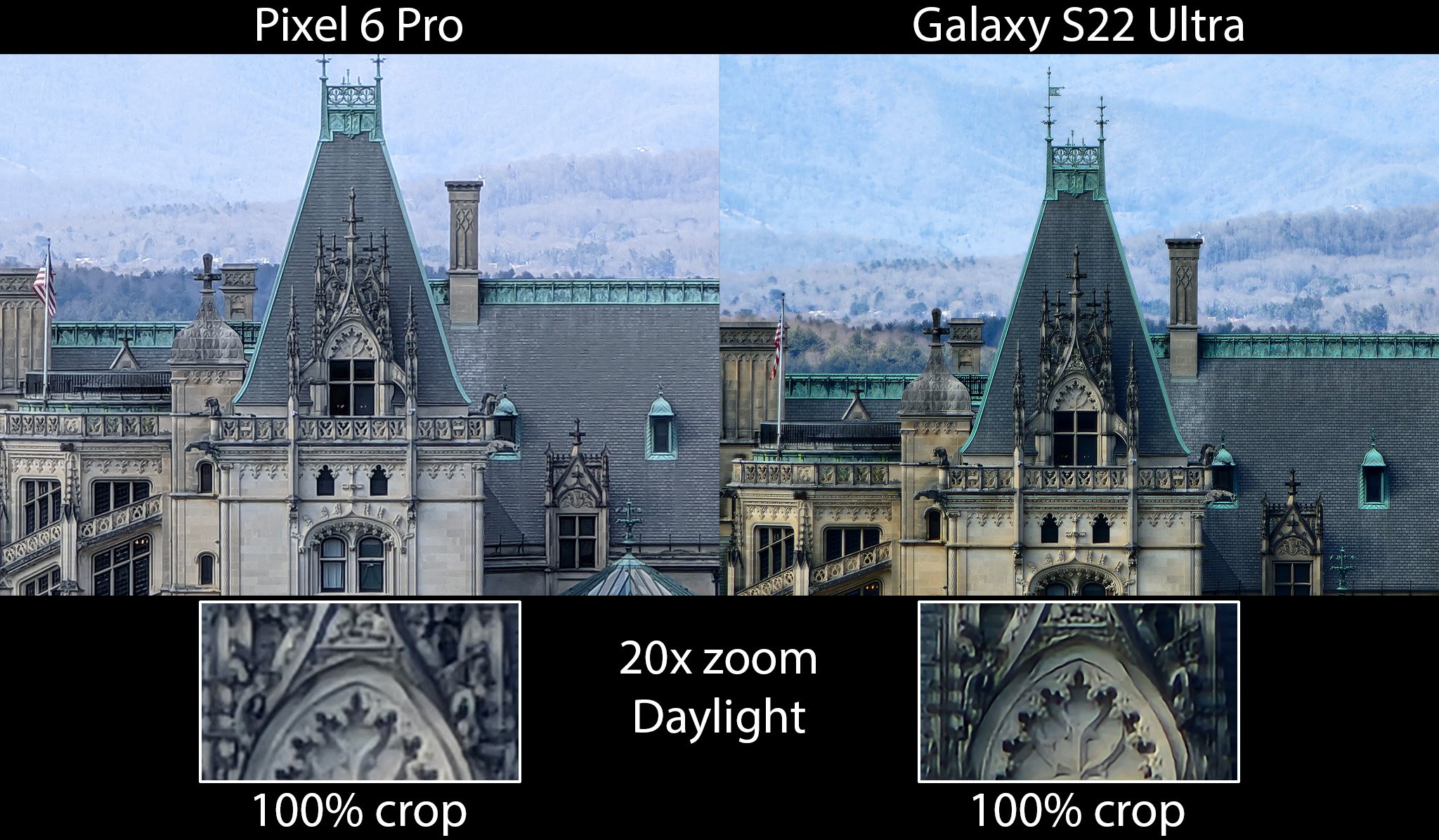
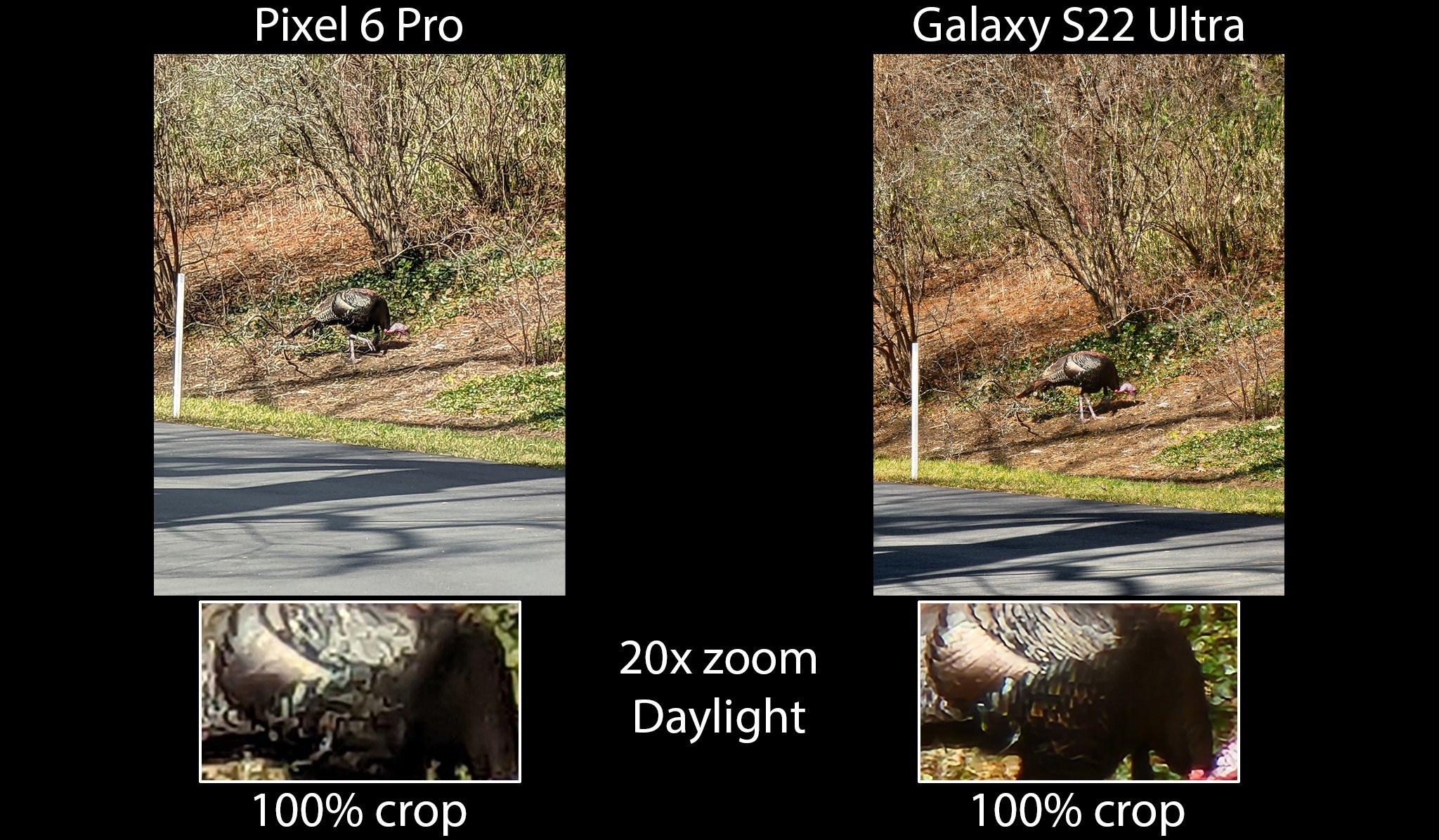


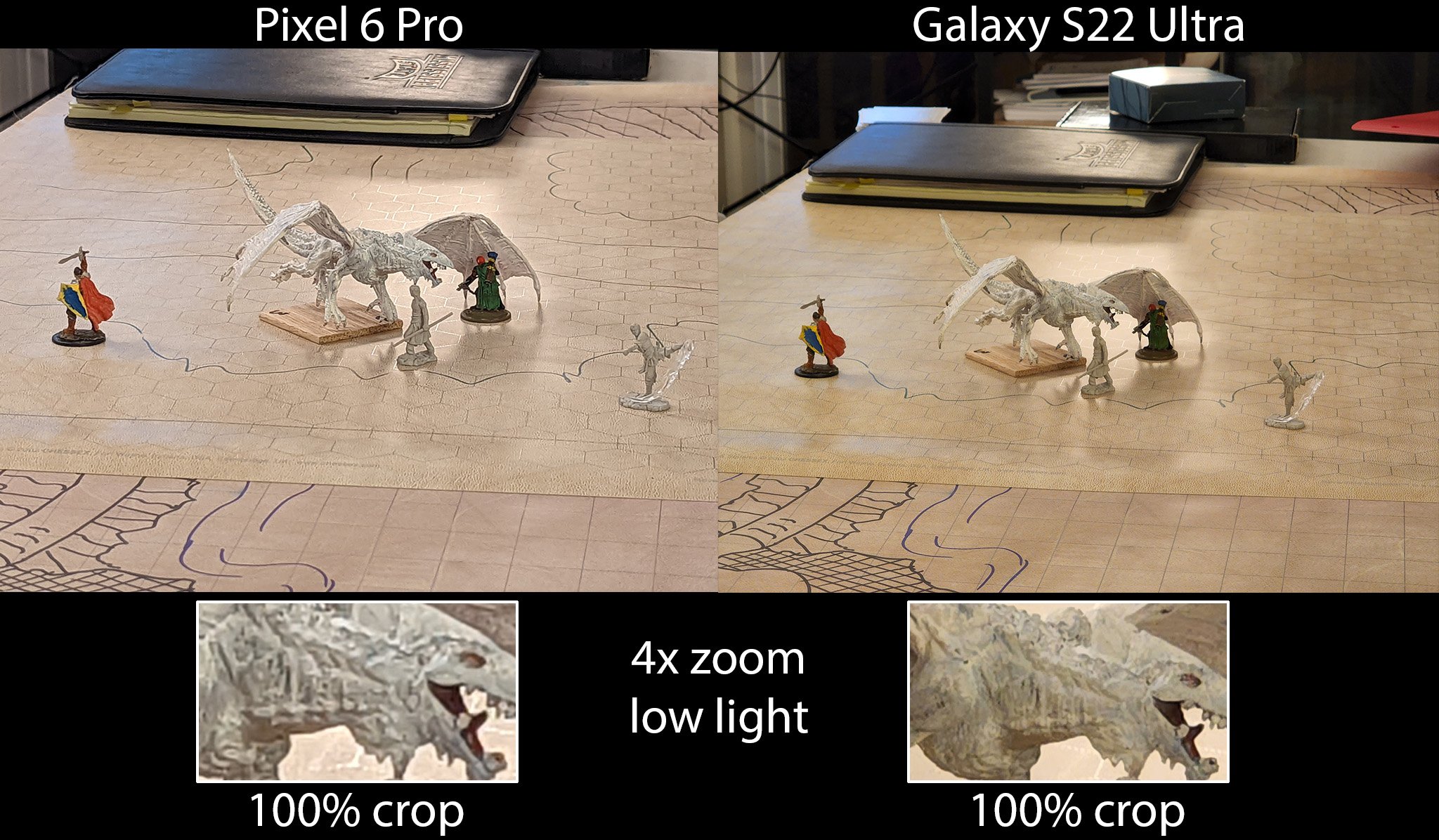
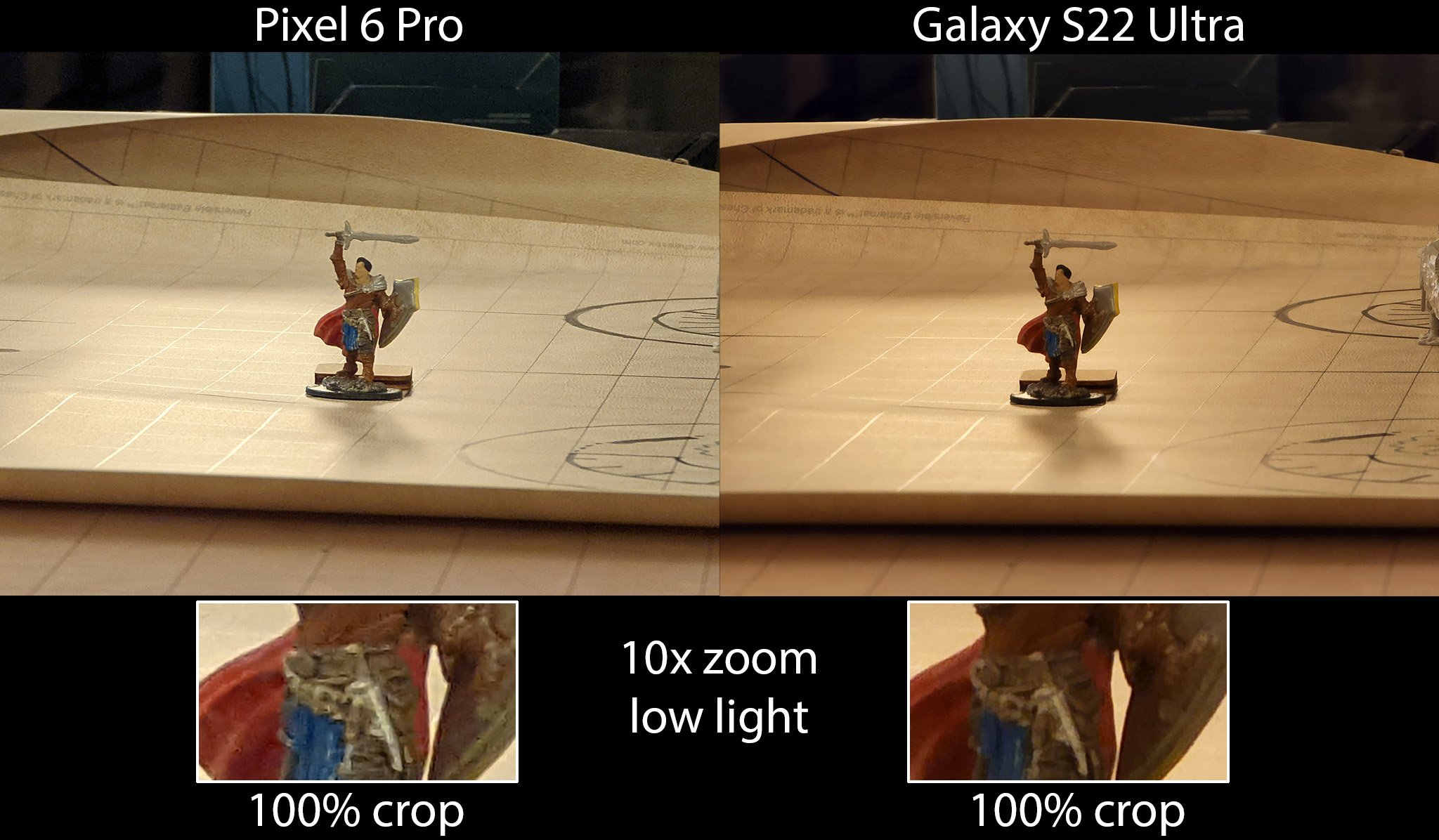
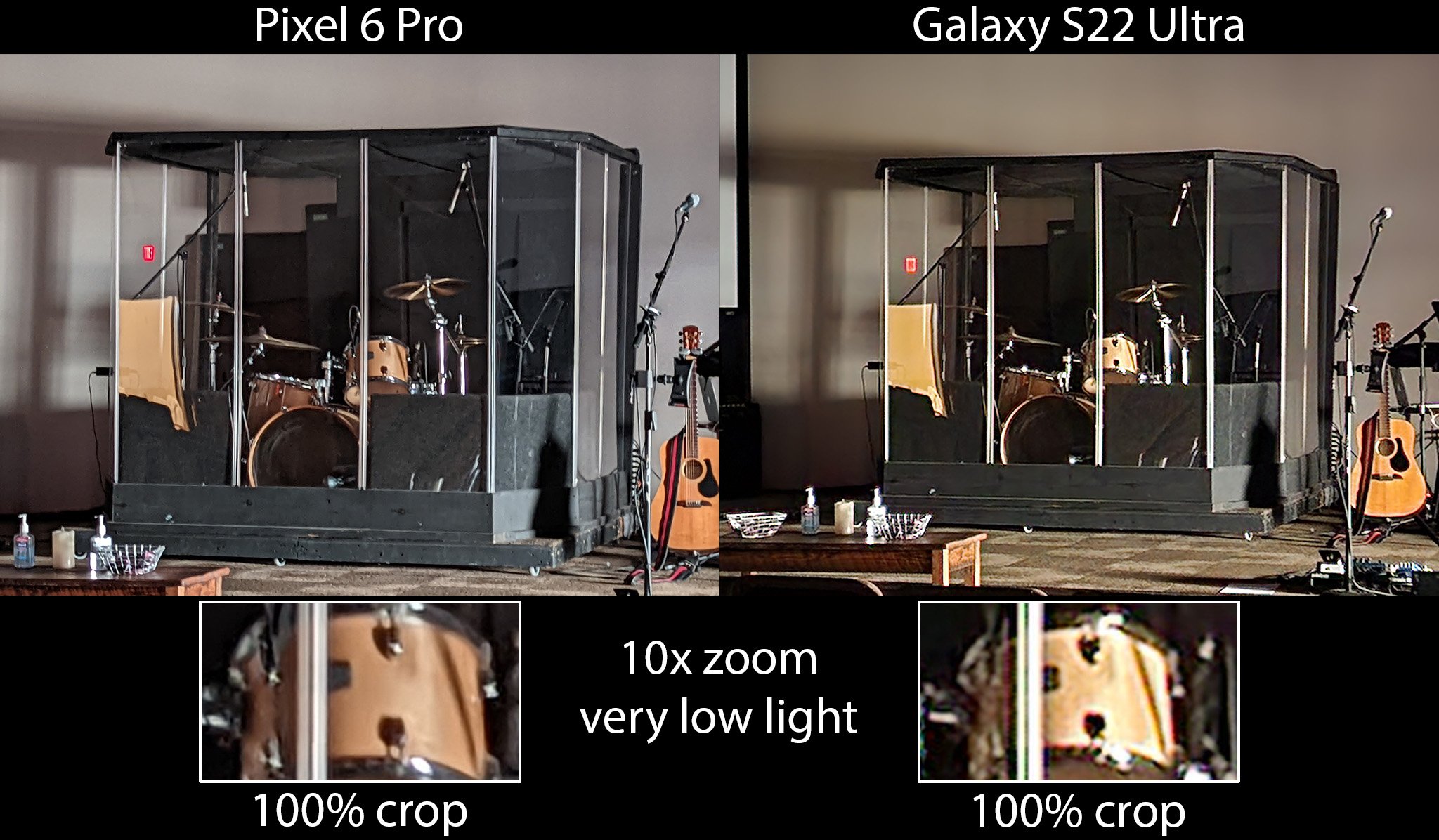

If you're looking for the very best telephoto camera, the Galaxy S22 Ultra is the phone for you.
If you're looking for the very best telephoto camera, the Galaxy S22 Ultra is the phone for you. During the day, the duo of 3x and 10x telephoto cameras work in tandem to deliver unparalleled imagery, even among its previous phones with the well-marketed 100x Space Zoom feature.
The improvement is best seen at zoom levels beyond 10x, where the 10x optical zoom telephoto lens can work in tandem with the phone's other sensors to deliver an image that I can only describe as "beauty in raw form." Often, these photos can exhibit a bit of chromatic aberration and other types of lens and sensor distortion in order to eke out as much detail as possible.
I was very pleasantly surprised to see Samsung allow this more raw look to its photos when it so often likes to overprocess them. Whether you're zooming in to see wildlife, read a sign from a far-off distance, or just want to admire the architecture of a downtown building, the Galaxy S22 Ultra has you covered.
If you're looking for a phone that zooms well in low lighting conditions without sacrificing detail, the Galaxy S22 Ultra is probably still the right choice. The difference between the S22 Ultra and the Pixel 6 Pro is much more neck-and-neck in these types of lighting conditions, though.
During my weekly D&D session — which stereotypically takes place in a basement — the Galaxy S22 Ultra did a better job of producing photos that were both free of noise and still full of detail.
The difference between the S22 Ultra and the Pixel 6 Pro is much more neck-and-neck in low lighting conditions.
Dropping to much lower lighting conditions flipped the results on their head sometimes. The results above speak for themselves; the S22 Ultra's images are sometimes extremely dark, grainy, and devoid of detail. Other times, as evidenced from my follow-up S22 Ultra vs Pixel 6 Pro nighttime photo comparison, Samsung does a better job at further zoom levels. Really, which phone wins depends highly on the specific situation.
Ultra-wide camera

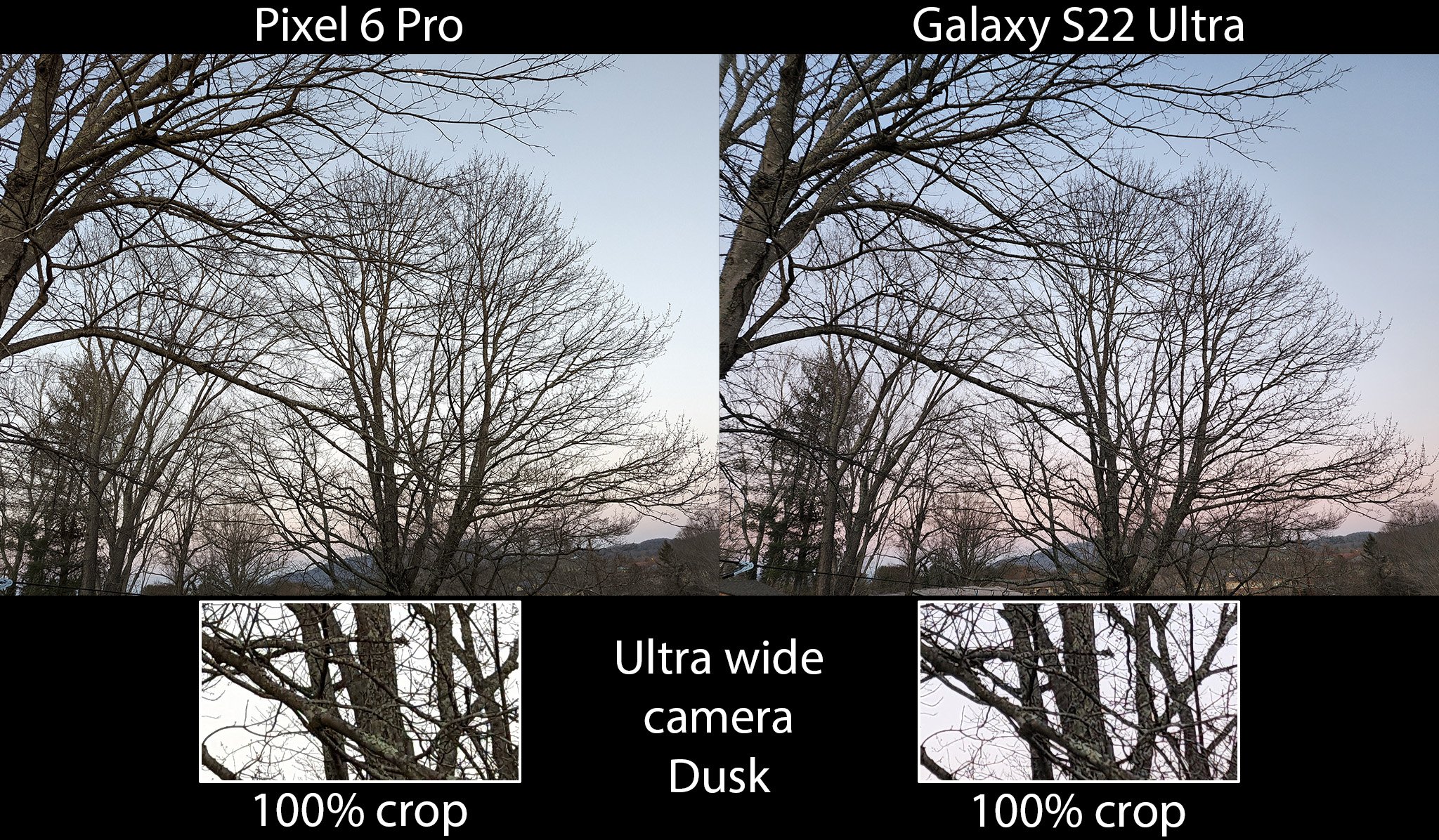
Processing for the ultra-wide camera on the Galaxy S22 Ultra is much more like what the main camera delivers versus what the telephoto cameras do. That means shots are a bit overprocessed and oversharpened, typically slightly underexposed, and usually, a little bit oversaturated.
In general, though, those complaints verge on splitting hairs. The overall image quality that comes from the Galaxy S22 Ultra's ultra-wide camera is superb and is almost always a great image, even if the Pixel 6 Pro slightly edges it out in the most important areas.
Front-facing camera and portrait modes

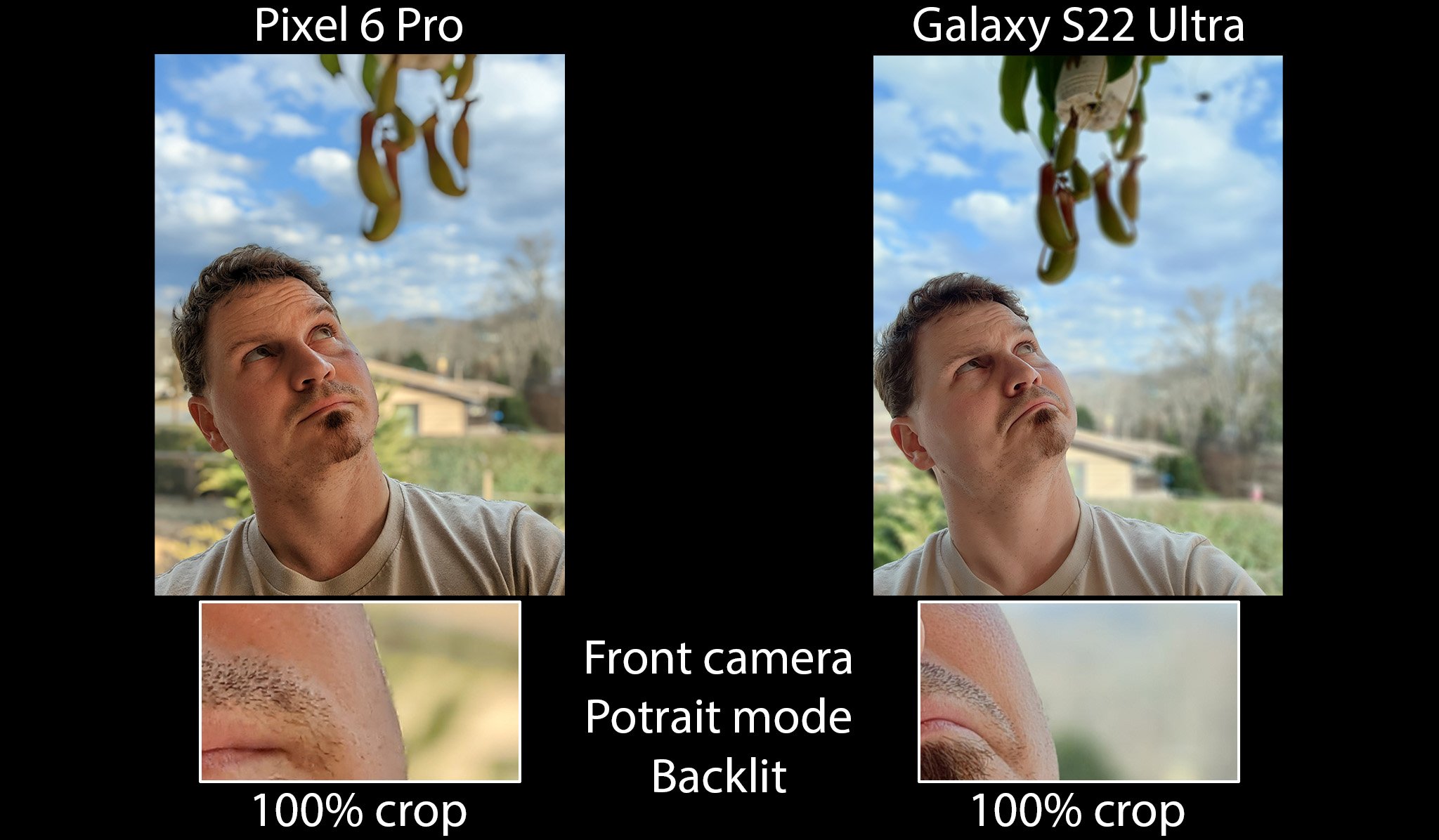
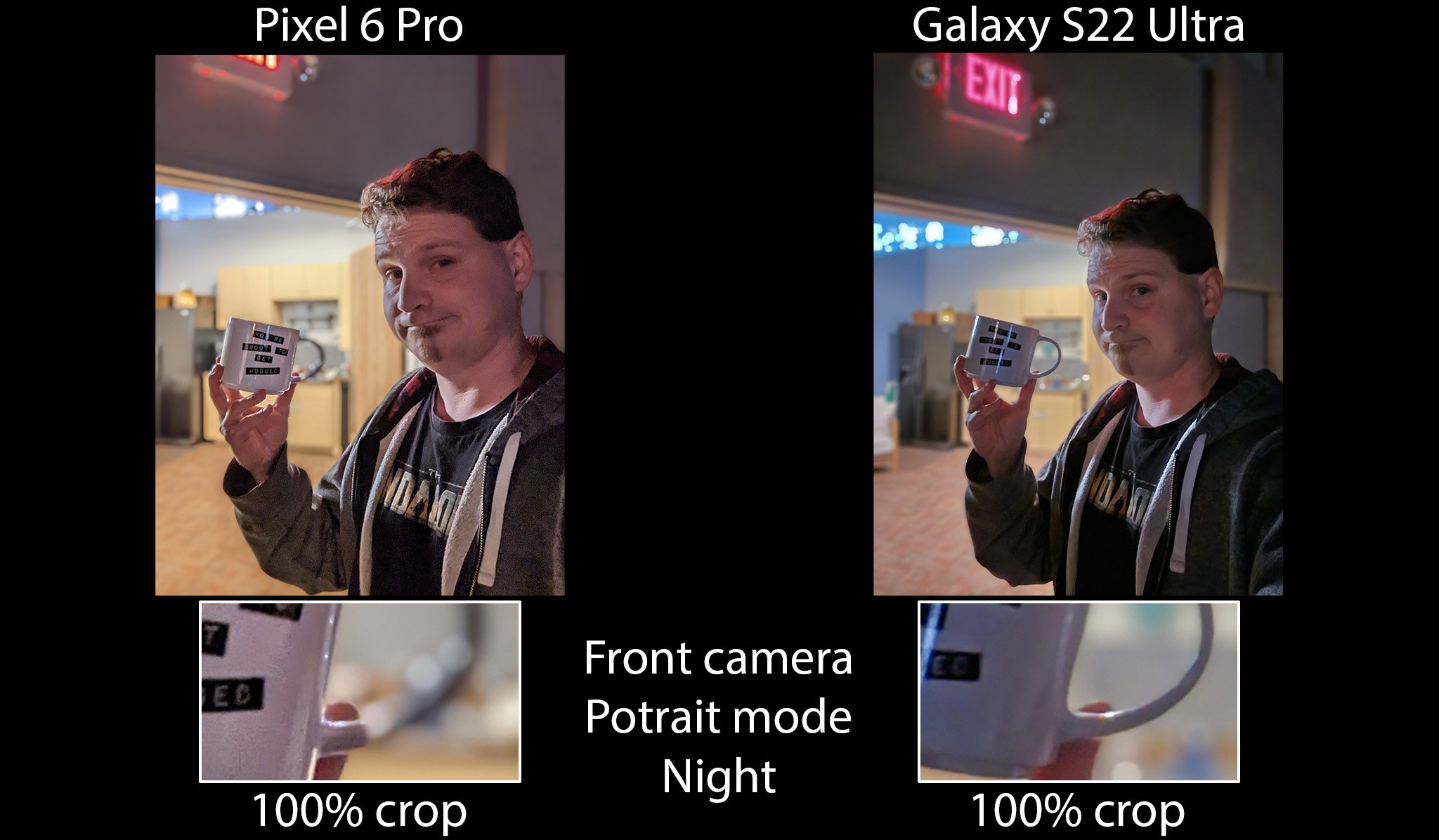
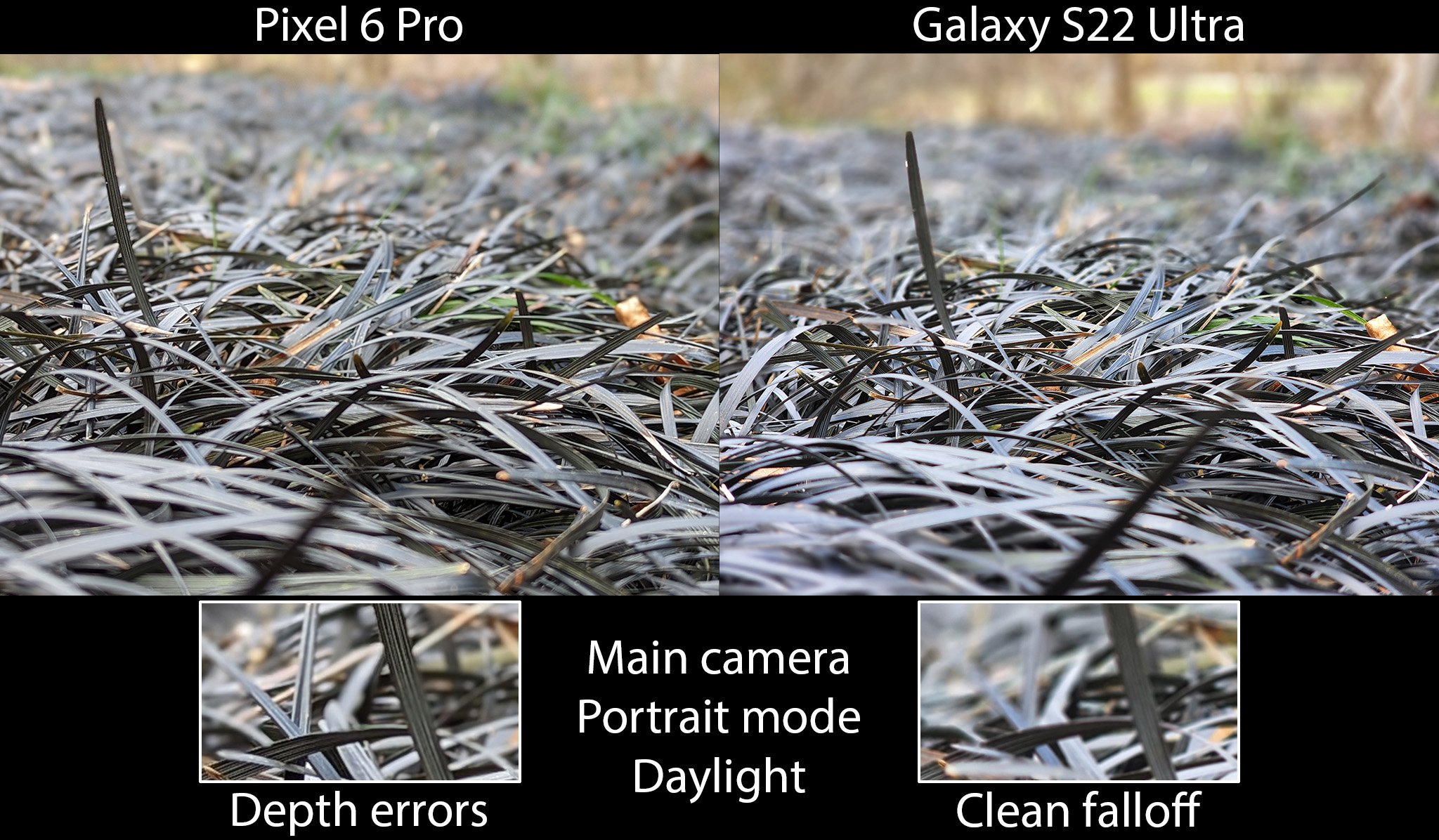
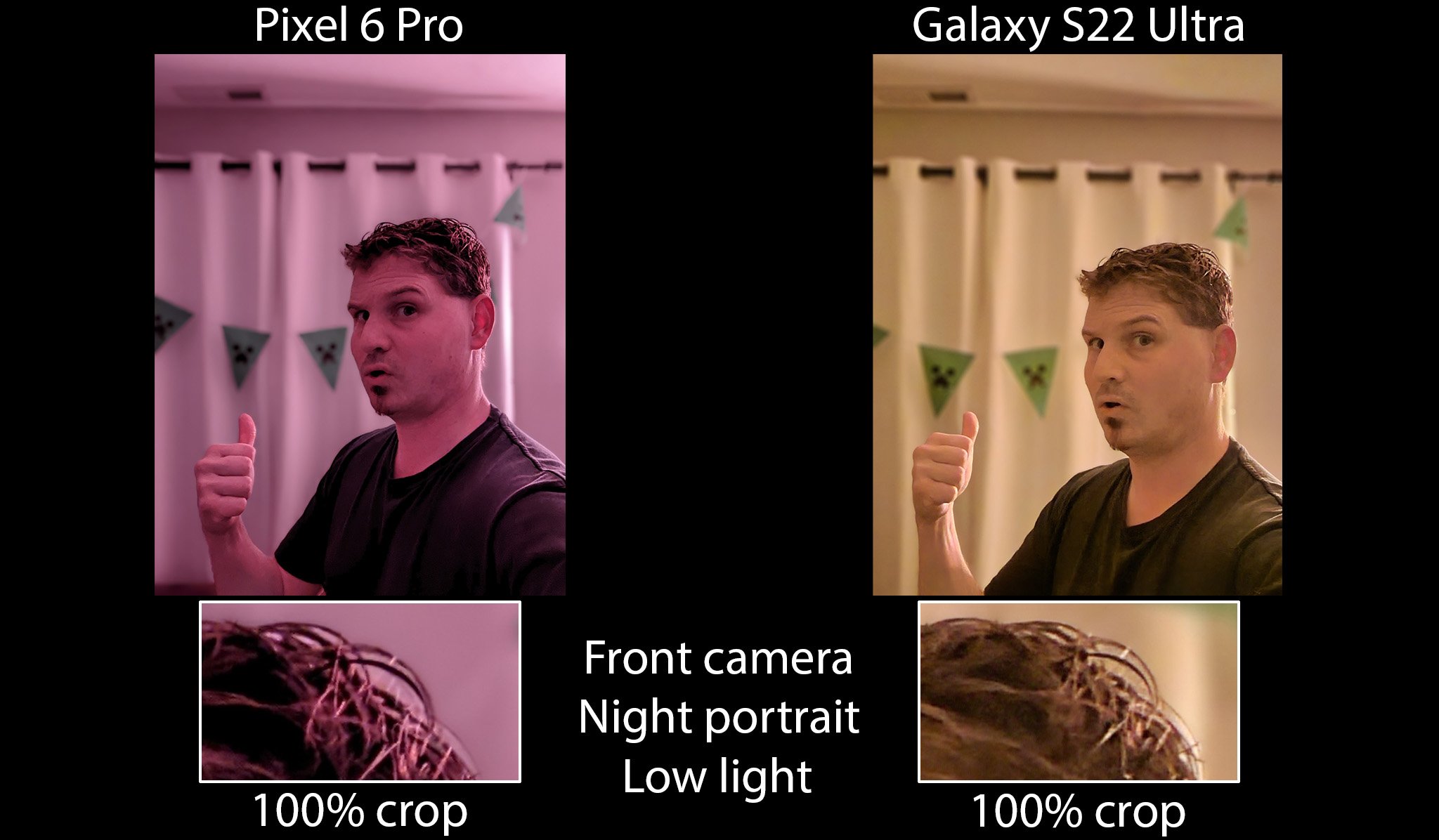
The Galaxy S22 Ultra delivers a superior portrait mode shot in every single situation.
With the Galaxy S22 Ultra, Samsung is introducing a new feature for its portrait mode that can be used on both front and rear cameras. This new feature, called AI Stereo Depth Map, uses object-identifying AI in tandem with a sensor's ability to measure depth to better approximate the actual boundaries of objects in a photo.
The result is a superior portrait mode shot in every single situation. Even fine hairs and tricky objects — like the handle of a mug — are properly identified and kept sharp while the rest of the frame is blurred in a convincing DSLR-like manner.
Samsung has also upgraded portrait mode with the ability to perform multi-frame capture — better known as night mode — automatically when the camera detects low light situations. In my experience, it's got to be quite dark out, and the objects behind you also need to be very dark.
Even if there are few or no lights in front of you, night mode won't kick in if there's a bright light behind you. I'd love a little more manual control over this, but, in general, the software seemed to do a good job of picking scenarios where night mode was necessary and automatically enabling the feature.
In summary, if you love taking portrait mode shots, the Galaxy S22 Ultra is the phone for you.
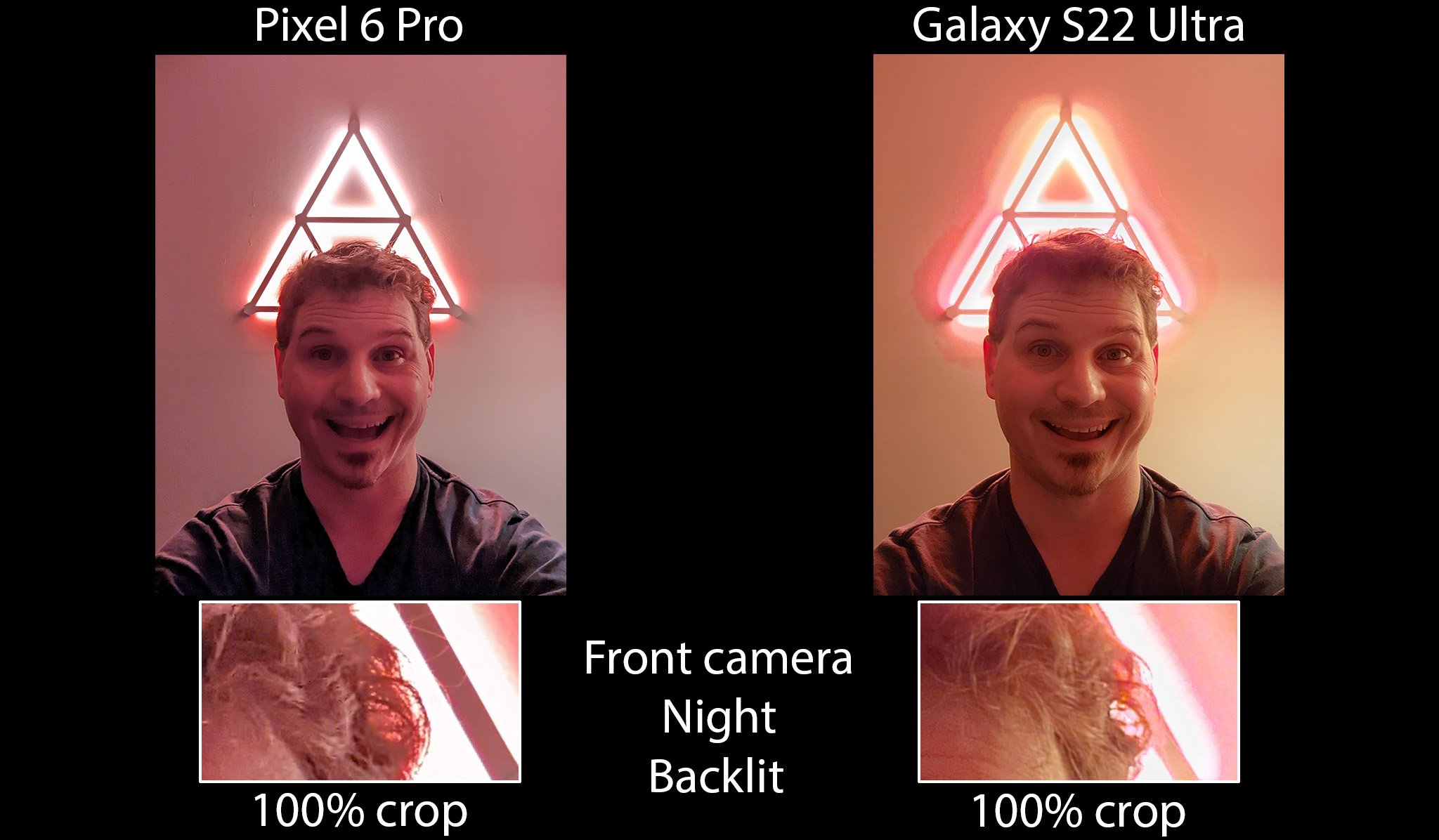
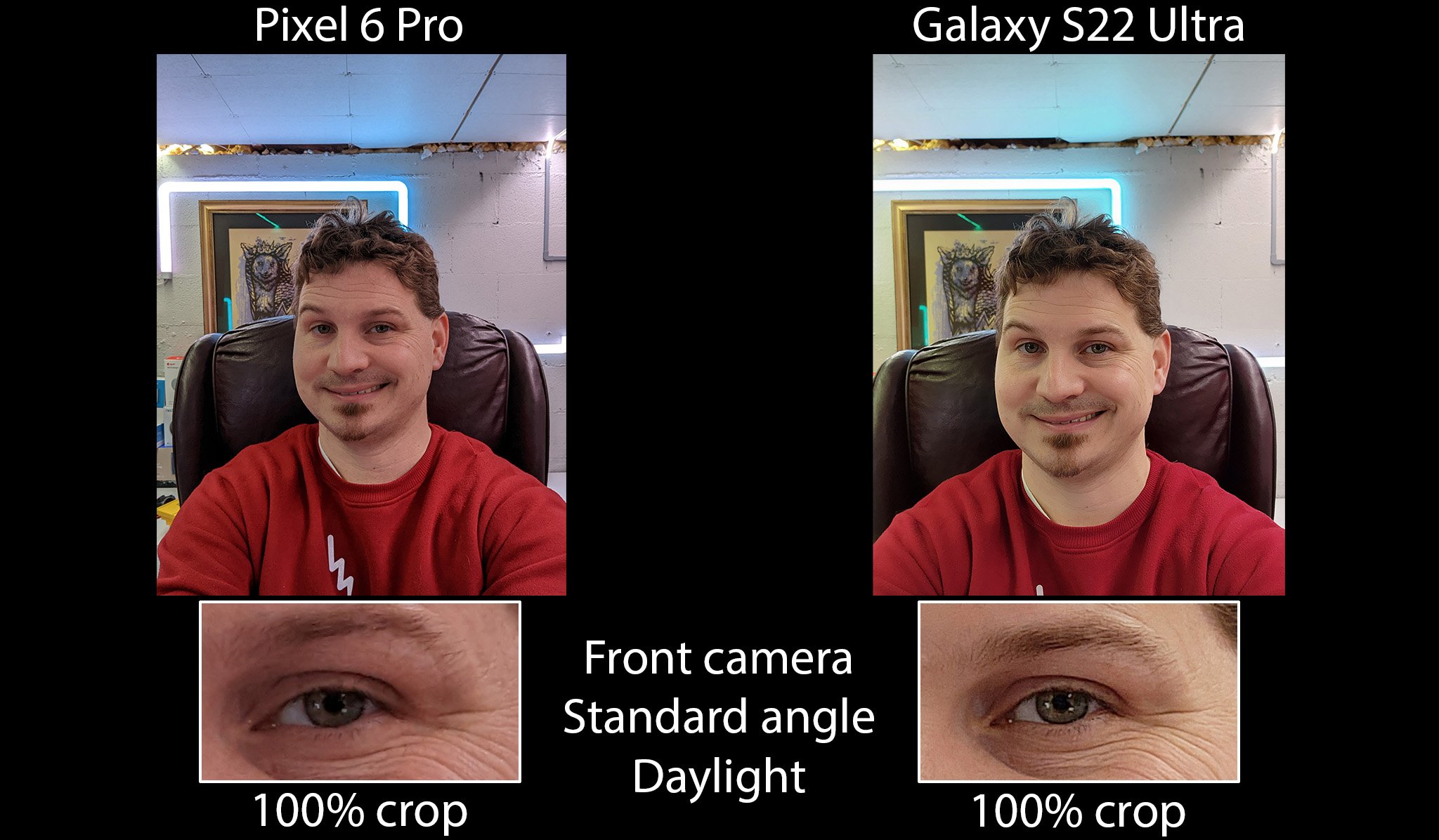
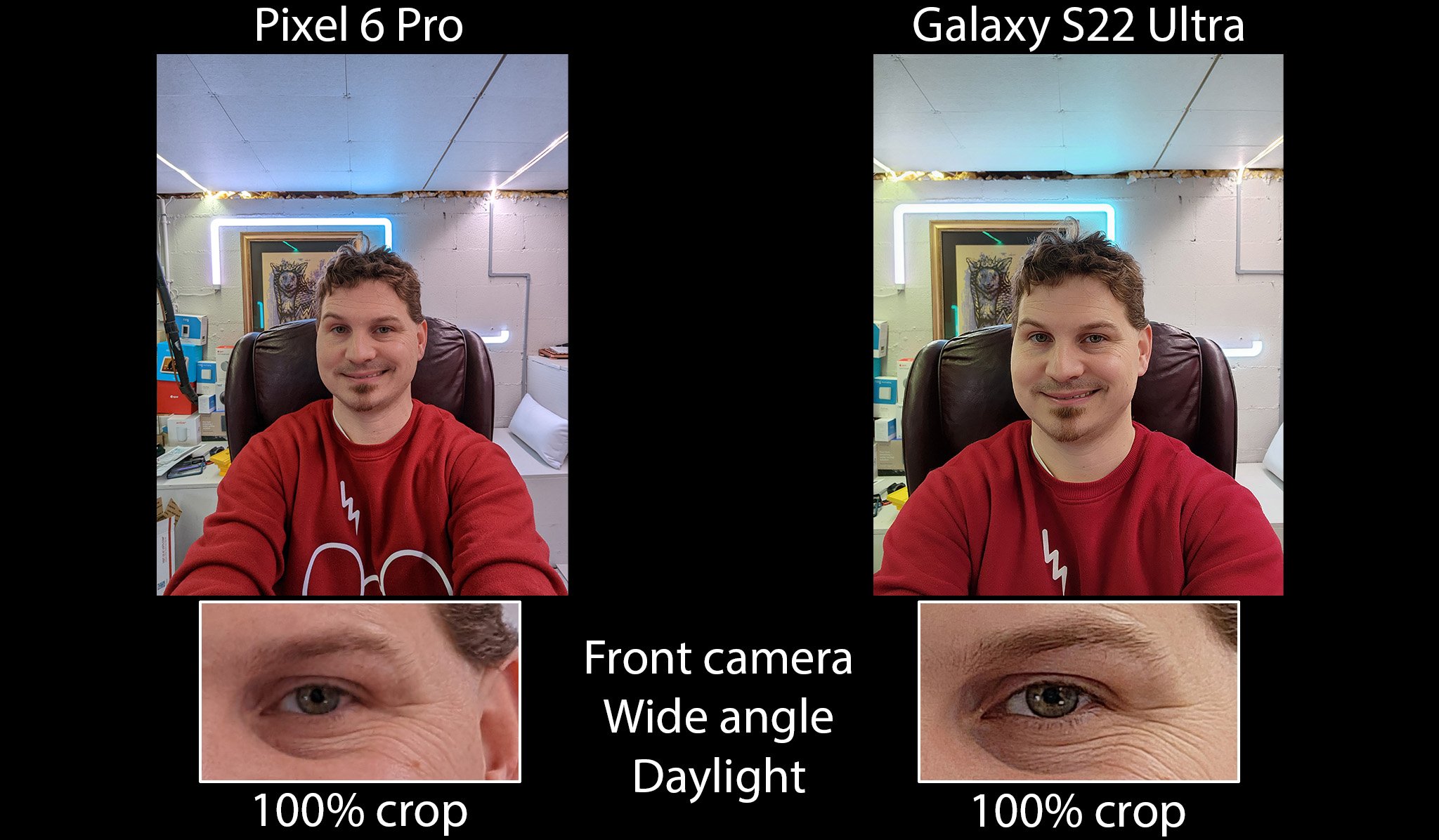
Meanwhile, the Pixel 6 Pro offers a wider lens for group shots. I'm not sure why Samsung doesn't go for a wider lens on its front-facing cameras, but the angle chosen is definitely very tight. By default, at an arm's length away, your face will fill most of the frame of the shot, leaving little of your surroundings in the frame.
A Pixel 6 Pro is better for group shots but, even with that said, photos from the Galaxy S22 Ultra's front-facing camera have more pleasant colors and more detail. It's basically the opposite of the main rear sensor.
The Pixel 6 Pro offers a wider lens for group shots, but the Galaxy S22 Ultra's front-facing camera captures more pleasant colors and detail.
Video recording
Before I get too far into comparing quality, I'd like to address a bizarre practice that Samsung still follows in too many ways. Out of the box, the Galaxy S22 Ultra is set to run at 1080p resolution on its display and record 1080p video from its front and rear cameras. While this is done to save battery and storage space, it's really a wholly unnecessary practice in 2022 when we have plenty of local storage (and free or inexpensive cloud storage).
As it stands, I'd be willing to bet plenty of people never switch to 4k resolution on their videos. That's a travesty that does these cameras absolutely no justice at all and needs to be fixed immediately. Now, onto the quality comparisons.
The Galaxy S22 Ultra has some of the best, if not the very best, front-facing video quality I've ever seen.
The Galaxy S22 Ultra has some of the best, if not the very best, front-facing video I've ever seen. Everything from the detail to the lighting, colors, and white balance, to the fact that it can eliminate background audio like nobody's business, makes this a superior experience in every way.
In the video above, I run through two scenarios; a well-lit day in a fairly thick bamboo forest — which introduces plenty of shadows and dimmer lighting conditions to boot — and my very own backyard at night. In both scenarios, the Galaxy S22 Ultra did a better overall job than the Pixel 6 Pro at capturing my voice and my face.
Additionally, you can see just how grainy the Pixel 6 Pro's front-facing camera is in low light when seeing these side by side. I still wish Samsung used a wider lens, but I'll certainly take the quality boost if I had to choose between the two.
Daytime video quality is pretty neck-and-neck between the two. The Galaxy S22 Ultra has slightly better stabilization than the Pixel 6 Pro, but I can't see anyone being unhappy with either of these results.
Colors look great on both cameras, detail is superb, and Samsung actually does a slightly better job of pulling in shadow detail toward the end of the shot when I go a little deeper into the bamboo forest. Really excellent stuff here.
The Galaxy S22 Ultra seamlessly swaps between cameras smoothly while zooming in or out.
Just as we saw with photo quality, Samsung continues to excel in video zooming smoothness. While both the Galaxy S22 Ultra and Pixel 6 Pro feature the same 20x zoom limitation during video recording, the Galaxy S22 Ultra does a far, far better job of switching between the cameras while zooming.
While watching the video, see how seamlessly the Galaxy S22 Ultra swaps between cameras as I zoom in and out to get a better view of the Biltmore. Meanwhile, the Pixel 6 Pro pops every single time it swaps between cameras, creating a jarring effect.
Samsung Galaxy S22 Ultra: Competition
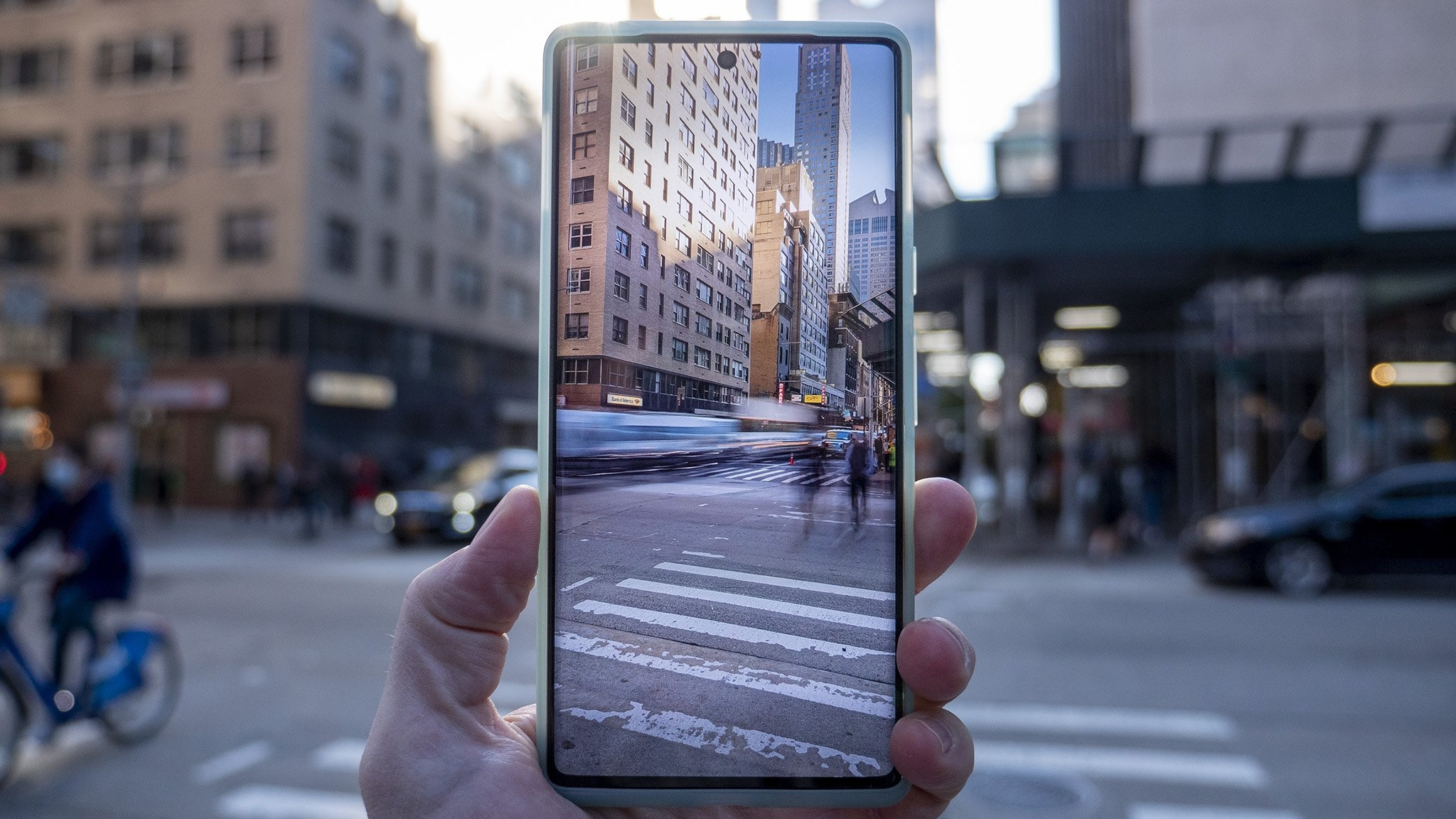
If it's not already apparent, the Pixel 6 Pro is the most direct competitor to the Galaxy S22 Ultra if cameras are your primary reason for choosing a phone. While the Galaxy S22 Ultra outclasses the Pixel 6 Pro in several areas, parents and pet owners will likely find that they prefer Google's rather intelligent algorithms that better choose a crystal clear photo, even when said subject just won't stop moving. You'll even save a few hundred bucks with the decision, too.
If you're more concerned with S Pen functionality, the Galaxy Z Fold 3 is more than just a worthy alternative. With a larger, folding screen and all the excellent features that come along with that, the Galaxy Z Fold 3 feels more like a proper notebook than the Galaxy S22 ultra ever could. The S Pen is also considerably larger and more comfortable. The two major downsides are that the Z Fold 3 is likely still more expensive than the S22 Ultra, and the S Pen can't fit into the Z Fold 3's frame, making it a cumbersome accessory to remember.
If you just want an excellent, feature-rich phone and don't want to shell out the big bucks, Samsung's Galaxy S21 FE is roughly half the price of the S22 Ultra and still offers great cameras, a nearly identical One UI experience, and a better-looking frame. Likewise, fans of smaller phones should choose the smallest Galaxy S22, as it offers (theoretically) better cameras than any S21 model and comes in a much smaller package.
Samsung Galaxy S22 Ultra: Should you buy it?

You should buy this if ...
- You've been missing the Galaxy Note (or need an upgrade)
- You like to take photos from far away
- You want the best video recording around
- You enjoy years of software support
You shouldn't buy this if...
- You take lots of pictures of kids or pets
- You don't need an S Pen
- You need two-day battery life
It's been a year since the Galaxy S22 Ultra came out, and you know what that means: the next one is right around the corner. We expect Samsung to unveil the Galaxy S23 Ultra on February 1, 2023, meaning you should only buy the Galaxy S22 Ultra if you absolutely need a new phone right now — i.e. your current phone is broken — or you can get an absolutely killer deal on it.
Even still, the Galaxy S22 Ultra is a superb phone that offers flexibility and features you won't find on any other 2022 phone. While the Galaxy Z series is literally more flexible since it bends, and the Galaxy Z Fold 4 has S Pen support, the S22 Ultra is the only one that has an S Pen holstered in its frame and also offers up to 100x Space Zoom.
For an enthusiast who loves zooming in and using the S Pen for all sorts of things, it's hard to argue with the Galaxy S22 Ultra.

The stunning return of the Note comes with a different name but the same familiar design, a cutting-edge processor and display, and the S Pen built-in. Vloggers and folks who love to post videos to social media like TikTok and YouTube will be especially happy with the new cameras, which are tailored to offer the best video recording capabilities and zoom detail of any phone.

